






By Harry Siemens
One attraction in Manitoba is an annual anticipation - the World’s Largest Pumpkin!
On Saturday, October 5, Charlie Bernstrom from Lancaster, MN, set a new record at the Great Pumpkin Commonwealth weigh-off during the Roland Pumpkin Fair. The 2014, 2017, and 2018 champion returned to claim the 2024 title with a massive pumpkin, smashing his 2018 record of 1,753.5 pounds. His giant pumpkin weighed 2,004 pounds, making it the most significant entry in the Roland Pumpkin Fair’s history.
The Great Pumpkin Commonwealth’s (GPC) mission is to cultivate the hobby of growing giant pumpkins and other giant fruits worldwide by establishing standards and regulations that ensure the quality of fruit, fairness of competition, recognition of achievement, fellowship, and education for all participating growers and weighoff sites.
This year marks the first time in Roland Pumpkin Fair history that an entry has surpassed the 2,000-pound mark. Bernstrom nearly achieved this feat last year, but a crack in his pumpkin,

discovered the day before the weigh-off, prevented it from competing. The crack extended into the pumpkin’s cavity, which would have led to disqualification. Out of curiosity, they weighed it at home, and it tipped the scales at an impressive 2,100 pounds.
Lancaster, Minnesota, is about an hour and a half from Roland, just 10 miles south of Minnesota on Highway 59. To haul a 2,000-pound pumpkin, they put it on a car trailer
securing it to a pallet before heading out.
He had always wanted to bring a giant pumpkin to Roland. After winning three times before, he was excited to bring a 2,000-pound pumpkin this year. Roland was where he entered his first weigh-off in 2013. He appreciates how well the event runs, the support, and the chance to see familiar faces.
The 2024 champion said growing a 2,004-pound pump-
kin takes much time, water, and fertilizer. Charlie spends about an hour and a half each day working on the pumpkins with help from his three daughters. His oldest daughter handles the morning watering during the school year since Charlie drives a school bus. The pumpkin requires about 100 gallons of water daily.
The water comes from the river near their home. However, the water’s pH is too high, so he uses 98% sulphuric acid to lower it to the correct level, essentially treating the water with a form of strong battery acid.
Bernstrom usually pollinates the pumpkins between June 15 and 20. At that point, the pumpkins are the size of a golf ball. By day 20, they reach around 80 pounds; by day 40, they’re close to 1,000 pounds, gaining 40 to 50 or more each day.
By Elmer Heinrichs
Agriculture and Agri-Food Canada, in its September report, says production of all principal field crops is estimated to have increased 1.8 per cent year over year, which would be 2.4 per cent above the previous five-year average.
On the Canadian Prairies, overall production is estimated to have increased 3.0 per cent and be 2.2 per cent above the previous five-year average.
For most principal field crops, better yields compared to 2023 drove these production expectations, combined with stable-tohigher areas for some crops.
Wheat production is expected to increase 4.1 per cent; oilseed production remains largely unchanged, coarse grains production is estimated to decrease 4.4 per cent and pulse and special crops production is estimated to increase significantly by 29.5 per cent.
Harvest is ahead of schedule for much of the Canadian Prairies, while the soybean harvest is just getting started in eastern Canada.
Prices for most principal field crops are forecast to decline year-over-year, in line with lower world values.
Uncertainty in the world’s grain markets remains elevated because of the Russian aggression against Ukraine and other ongoing geopolitical risks.
Continued on Page 2...
When the Roland Pumpkin Fair approaches, timing becomes critical, as the pumpkin must be ready. He said it’s important to start early enough because of the risk of frost, which can occur late in the season. Luckily, September was nice, and they had their first frost the morning he picked the pumpkin.

By Harry Siemens of Canada Packers.
Once Maple Leaf Foods completes the planned separation of its pork business into an independent public entity, the new name for its new pork company will be Canada Packers.
“We are thrilled to launch Canada Packers as the new name for our future independent pork company,” said Dennis Organ, President of Maple Leaf Foods’ Pork Complex and incoming CEO
“This choice reflects our deep respect for the history and legacy of this iconic brand while allowing us to bring it forward and blend it with our ambitious vision for the future as a world-leading pork producer.”
Canada Packers’ heritage in the pork industry stretches back nearly a century, and the new company aims to build on this legacy as a leader focusing on sustainable solu-
tions and global reach.
“Canada Packers is a distinctive, memorable, and authentic name for the new pork company,” said Curtis Frank, President and CEO of Maple Leaf Foods. “While grounded in solid roots that have been an important part of Maple Leaf Foods’ history, Canada Packers also provides a platform for the forward-thinking vision that Dennis and his team have embraced as they chart their

Bernstrom’s interest in growing pumpkins started around 2012. Now, it’s become a family activity. His three daughters help out, and it’s turned into a fun tradition where they name the pumpkins, sit on them each week for pictures, and try to make the pumpkins look bigger by “shrinking” the girls in the photos.
After Bernstrom takes the pumpkin home and uses it to raise money,
their town hosts a festival featuring a pumpkin drop. His wife, a kindergarten teacher, is on the county literacy council, and they use the event to raise money for books for kids. Each month, children from birth to five years old receive a free book in the mail. The event typically raises about $1,500 and draws 400 to 500 people.
During the festival, they drop the pumpkins on various objects. When they
Continued from Page 1...
drop the pumpkin, it breaks whatever it lands on, and the pumpkin shatters. After the pumpkin shatters, Bernstrom cuts out the seeds to save them for the next year or share them with others interested in growing their pumpkins. Once the seeds are collected, people often grab pieces of the broken pumpkin to feed their livestock or use however they see fit. It turns into a fun way to ensure the pumpkin gets fully used.
next steps as an independent company. We are excited for what the future holds for Canada Packers as we advance plans to complete the separation of the businesses in 2025.”
The new branding includes elements from its nearly 100-year-old logo, featuring the capital “C” and “P” and a refreshed Canadian flag. The colour palette has shifted from blue and red to natural green and blue tones, symbolizing the company’s commitment to sustainability and connection to Canada’s landscape.
“Leveraging the historical past was key, but not at the expense of the future and progress this brand represents,” added Organ. “The new branding honours these roots while propelling Canada Packers towards a dynamic and innovative future. We expect the new Canada Packers logo and branding to be a beacon for leadership in the fresh food space globally for
another hundred years.”
Once independent, both Maple Leaf Foods and Canada Packers will focus on their value-creation strategies while maintaining their leadership in safety and sustainability. Maple Leaf Foods will continue to be a leading consumer packaged goods company. At the same time, Canada Packers will leverage its expertise to grow as a global leader in sustainably produced pork.
Upon completing the separation, Maple Leaf Foods will retain a 19.9% ownership in Canada Packers and enter into an evergreen pork supply agreement. This agreement will ensure Maple Leaf Foods has access to highquality, sustainably produced pork while providing Canada Packers with a key customer in North America, transacting at market-based formula pricing.

The new branding includes elements from its nearly 100-yearold logo, featuring the capital “C” and “P” and a refreshed Canadian flag.
Independent Mara Rozitis of Tache, MB, owner of Signature Swine Solutions, shared her thoughts on the situation, saying, “First, I’m relieved to see it remain Canadian. I was quite concerned that it would be sold to an offshore interest, as Hylife was. Selling off our ability to feed ourselves is always a mistake.” Rozitis also praised the decision from a business perspective.
“Second, I think it’s a brilliant marketing move. The nostalgic name will immediately appeal to the older generations, buying time to rebrand to the new identity,” she said.
First announced in July 2024, the company expects to spin off Canada Packers as an independent, publicly traded company in 2025.
By Harry Siemens
Maple Leaf Foods unveiled Canada Packers Inc. as the future name of its new independent pork company after separating from its pork business. Dennis Organ, President of Maple Leaf Foods’ Pork Complex and incoming CEO of Canada Packers, expresses excitement about the name, which reflects the brand’s deep history while blending with its ambitious vision for the future. The company focuses on becoming a global leader in sustainable pork production, building on Canada Packers’ legacy as an industry leader committed to sustainability and global reach.
Cam Dahl, general manager of Manitoba Pork Council, shared his thoughts on Maple Leaf’s pork division becoming Canada Packers.
“It’s kind of reviving the past. I guess it’s sort of like the Jets coming back,” he said. “It’s going to allow the company to focus more on the pork and pig businesses,”
toba despite initial concerns and questions surrounding the direction of the pork division. While there is still some uncertainty, he maintained that the outcome looks promising for the province’s pork sector.
Some may think he’s viewing the situation too optimistically, but he disagrees. He pointed out that the Brandon plant, which isn’t running at total capacity, will be a focus for Canada Packers. This shift will increase the demand for pigs, which benefits farmers, creates more jobs in the province, and boosts investment. Dahl emphasized that he sees the changes as a positive development for Manitoba.
Bill Alford, general manager at h@ms Marketing Services Co-op in Winnipeg, MB, also commented on the announcement that Maple Leaf’s hog sector will become Canada Packers. He noted that the news releases don’t provide much detailed information regarding the limited specifics.
unfold. He pointed out uncertainties regarding how the pork sector’s spin-off will be structured, including shares and company organization details.
According to the company news release, Maple Leaf Foods will hold a 19.9% ownership stake in Canada Packers once the separation is complete. Both companies will establish an evergreen pork supply agreement. This deal will ensure that Maple Leaf Foods continues to have reliable access to high-quality, sustainably produced pork. At the same time, Canada Packers secures a major North American customer with transactions based on market-driven pricing formulas.
Alford acknowledged its business as usual for now but
tion to Canada Packers will
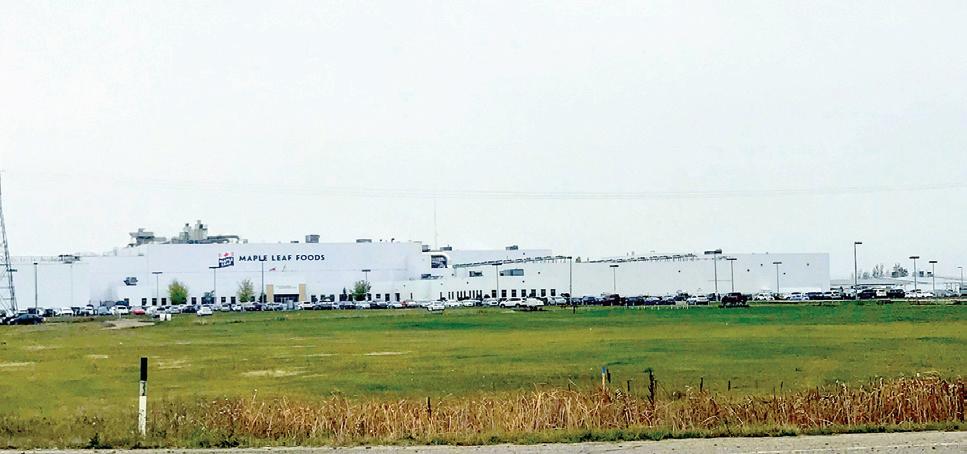
According to other industry sources, there remains uncertainty regarding the details of Maple Leaf Foods’ upcoming ownership changes. While Maple Leaf has stated that it will retain 19% ownership in the new Canada Packers entity, the question of who will own the remaining 80% remains unclear. These sources indicate that both employees and those on the ground are still in the process of learning how the changes will ultimately take shape, with many unsure of how the new structure will look once finalized in 2025.
By Harry Siemens
Driving through Steinbach, Pine Ridge Hollow, and along Highway 3 in Manitoba this early October, fields showed much blacker soil than usual, with farmers actively increasing their tilling efforts. In some areas, they tilled the fields for a second time, something rarely seen in a typical season.
The long fall has fuelled significant volunteer growth, pushing farmers to take additional steps to control the overgrowth. This heightened tillage raises questions about whether the extended season has made double tilling necessary and how farmers adapt to these unique conditions.
“In general, most farmers typically till their cereal fields as well as soybeans and corn, while they usually just harrow their canola unless there’s significant volunteer growth,” explains Jason Voogt owner and operator of Field 2 Field Agronomy Inc. “If there’s a lot of growth, they’ll till that too. Tillage is very common most years. Although two passes aren’t typical, because of the volunteer growth this year, many have sprayed it and then tilled or just tilled.”
Voogt also notes that drainage work has been another factor driving tillage.
“Guys have been doing a lot of drainage, so they’ll till to spread out the soil they’ve scraped up. It’s been so wet that they’re tilling to dry things up and smooth out ruts left by sprayers or combines.”
Another reason there has been more tillage is because we have had a lot of cereal residue.
Brunel Sabourin, an agronomist, noted that this fall’s moisture and hot weather have led to above-average regrowth, resulting in the need for more tillage.
“Some fields with excessive regrowth were waiting to get baled before getting 3-4 inches of rain, so they haven’t even received their first pass yet,” Sabourin explained.
Farmers also use the current good soil moisture to do more tillage after consecutive dry years with less tillage activity.
However, Sabourin pointed out, “Some fields have been worked pretty black, and they were already blowing this weekend, which is never good. It will be a long winter if we don’t get adequate snow cover on those fields.”
Tom Teichroeb a rancher at Langruth, MB offered several reasons for the un-
By Elmer Heinrichs
It looks like Canada’s largest aquaculture farm growing Arctic Char is coming to the RM of Rockwood north of Winnipeg.
The Manitoba government is supporting the $145-million development of a new Arctic Char facility providing more than 100 fulltime jobs for Manitobans and growing the provincial economy.
It would also be Canada’s most central land fish farm, with most other facilities in British Columbia or on the east coast. The project will also be Canada’s largest Arctic Char facility.
Manitoba officials also said it is financially supporting the plan with a loan of around $10 million. The province’s trade and natural resources minister Jamie Moses and agriculture minister Ron Kostyshyn both
said the facility will contribute to Manitoba’s economy.
Jamie Moses highlighted the government’s commitment to job creation and economic growth, emphasizing that the facility will expand opportunities in Manitoba while producing sustainable food.
The large facility, located at the former site of the department of fisheries and oceans’ Rockwood Experimental Fish Hatchery, aims to position Manitoba as a leader in the industry.
Ken Blair, CEO of Sapphire Springs Inc., expressed gratitude for the province’s support and outlined the company’s goal of becoming a leader in sustainable aquaculture. He stressed the project’s role in supporting the local economy and meeting the rising demand for healthy, sustainable protein sources.
usually black fields and increased tilling activity.
“Some of those really black fields could be too wet to seed earlier in the year,” he explained.
He also pointed out that some farmers might be cultivating a second time to incorporate fall fertilizer, while others may opt for a second pass with wider cultivation shovels to create more soil disturbance.
“When going into a bean rotation, some guys want no straw left behind,” Teichroeb added. He humorously mentioned that a few farmers simply enjoy what he calls “recreational tillage”, relishing the opportunity to work the fields even if it’s not strictly necessary. These various factors help explain the increased tillage seen this year.
The increased tilling activity observed across Mani-
toba this fall stems from a variety of factors, each playing a significant role in how farmers manage their fields this year. From the long fall encouraging volunteer growth to farmers taking advantage of good soil moisture following dry years, these efforts reflect both necessity and opportunity.
Experts like Jason Voogt, Brunel Sabourin, and Tom Teichroeb have highlighted reasons such as drainage work, fall fertilizer incorporation, and even recreational tillage as key contributors to the blackened fields and second passes seen this season.
While weather and crop residue challenges present extra work for farmers, these adaptive strategies showcase their resilience and dedication to maximizing field conditions and crop success.
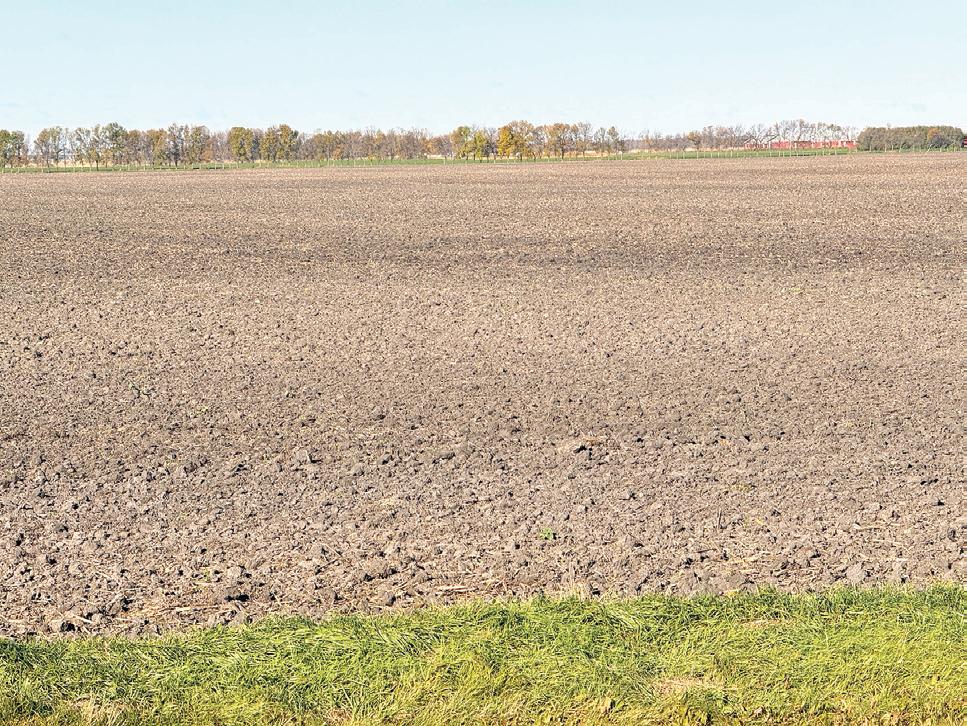

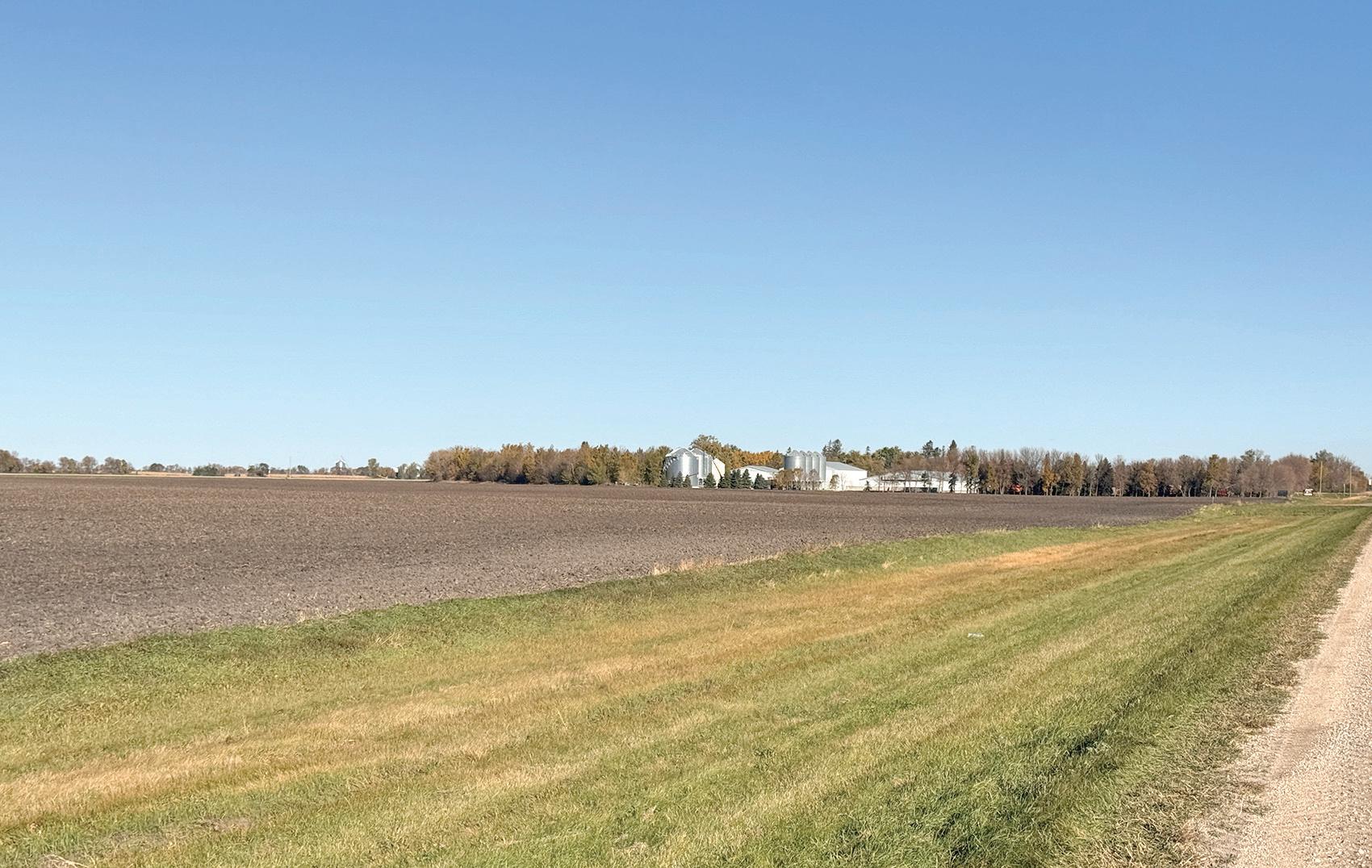
growth this year, many have sprayed it and then


Read the AgriPost online at agripost.ca

Thanksgiving is always a special time of reflection. This year, I am particularly grateful as a farm journalist deeply rooted in Manitoba’s farming community. This community is not just a part of my professional life but also my personal one. This season, I reflect on how farmers in our region—grain, cattle, and pig producers— embody the true essence of hard work, dedication, and perseverance.
Having witnessed more than 70 harvests, including the ones I grew up working alongside my father and brother, this year’s harvest holds its own set of memories and challenges. Manitoba farmers, whether producing grain, raising cattle or managing hog operations, have faced a year of unpredictable weather, just like we did. Yet, in the end, as
always, the land gave back, yielding crops that are now being stored, processed, and prepared for local and global markets.
Something is humbling about seeing these fields, which might have been brown and cracked just months ago, now mostly tilled and ready for winter, patiently awaiting the following year’s crop. The cycle of life on the farm never stops, and even as we wrap up this year’s harvest, we’re already looking ahead to what the next season will bring. It’s a reminder of the constant work and preparation that goes into farming and the faith we place in the land, knowing that with care, it will provide again.
This rhythm, this unending cycle, is what makes farming such a unique and rewarding way of life. It mirrors life in many ways—working through the challenges, trusting in what’s to come, and always giving thanks for the blessings.
Grain farmers have dealt with commodity price fluctuations, and many are stor-
ing grain, hoping that market shifts will work in their favour. But that’s part of the life of a farmer—knowing that what happens in global markets will influence the family’s livelihood right here in Manitoba. Cattle producers are bringing in their herds from pasture with some of the best fall conditions we’ve seen. Pig producers continue their diligent work, managing the health and growth of their livestock while contending with changing market demands and pressures from various sectors. What gives me even more joy this Thanksgiving is celebrating a personal milestone. Angelinda and I are celebrating four months of marriage. I can’t help but draw a connection between the patience, care, and hard work farmers put into their land and livestock with the love and commitment that builds a strong marriage. Just like a farmer needs to tend the land, giving it what it needs to grow, we have nurtured our relationship, grounded in faith and love, trusting God’s plan.
This year, I’ve also connected closely with my fellow farmers and agricultural professionals through WhatsApp groups and X, which has proven invaluable. Being part of these conversations keeps me current, whether about moisture levels, harvest progress, or the latest technology. The early investment I made in technology in 1982, buying my first computer, has paid off more than I could have imagined, especially in this digital age.
So, this Thanksgiving, I raise my heart in gratitude for the work of Manitoba’s farmers and the incredible farm families that form the backbone of this province. They are the lifeblood of our rural communities, and their resilience in the face of challenges is truly admirable. They work through the ups and downs with determination and an unwavering spirit. For that, they deserve our utmost respect and appreciation.
Celebrating with Angelinda and reflecting on our journey reminds me of the impor-

tance of family, love, and faith. To Manitoba’s grain, special crops, corn, canola, cattle, and pig producers: I see, appreciate, and stand with you. Your work doesn’t go unnoticed, and I join you in giving thanks for another year of bounty despite the many challenges. This year is a Thanksgiving where we remember not just what we’ve harvested from the fields but the relationships we’ve cultivated and the resilience we’ve shown.
May God bless all the families, the workers, the suppliers, the agronomists, the machinery operators, and every hand that touches the food that eventually graces our tables. Happy Thanksgiving to all! May we continue to be thankful for the big and small blessings that come our way.
Canadian cultivated farmland values rose by an average of 5.5 per cent in the first half of 2024, according to the mid-year farmland values review by Farm Credit Canada (FCC). Over the 12 months from July 2023 to June 2024, there was a 9.6 per cent increase, representing a slowdown compared to the previous 12-month period (January to December 2023).
“Farmland values increased at a slower rate, yet 5.5 per cent growth in six months is still a very strong number,” said J.P. Gervais, FCC’s chief economist.
For the second consecutive year, Saskatchewan and Quebec have recorded the highest average six-month increases in the country, at 7.4 per cent and 5.4 per cent, respectively. The rates in New Brunswick,
British Columbia, and Alberta all settled in the same range, 5.2 per cent, 5.0 per cent, and 4.6 per cent, respectively.
Manitoba recorded a growth rate of 3.9 per cent, closely followed by Nova Scotia at 3.8 per cent. Ontario recorded a lower increase at 2.1 per cent, with Prince Edward Island concluding the list at 1.7 per cent.
Elevated borrowing costs,
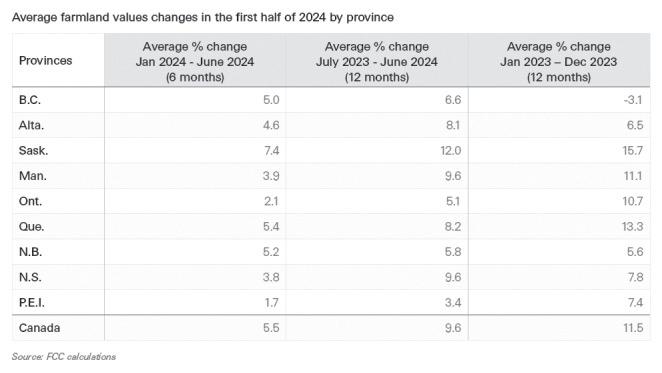
lower commodity prices and the increased price of land hasn’t deterred some buyers. Looking ahead, declining borrowing costs and a limited supply of available farmland should sustain the current high prices for farmland.
“The continued rise in farmland values highlights a positive and robust long-term outlook for the agriculture sector. As we move into the latter half of 2024, the trends in farm revenues and interest rates will be key indicators of where farmland values might head next,” said Gervais.
Gervais noted that farm cash receipts are projected to decline overall in 2024 by 3.3 per cent as commodity prices show few signs of a quick rebound, possibly limiting farmers’ willingness and capacity to assign higher valuations to farmland.
“Understanding economic and financial trends is essential for making informed decisions. FCC is committed to providing the industry with data-driven insights that can help producers and investors navigate the current economic headwinds,” added Gervais.
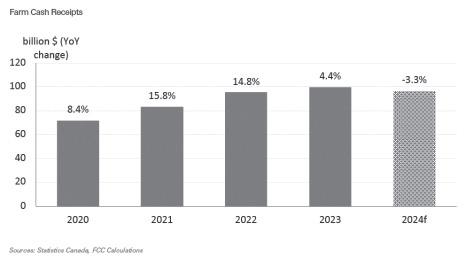
By Elmer Heinrichs
Harvest operations across the province are starting to wind down as the last of the 2024 crops come off the fields.
The October 16 crop report pegged the overall provincial harvest at 93 per cent complete, up 8 points on the week and with mainly just corn and sunflowers still to go.
Central region’s harvest advanced 4 points from the previous week to reach 98 per cent complete, while Eastern region jumped 16 points to 91 per cent done.
An estimated 39 % of the provincial corn crop was off, while sunflowers were 22 per cent harvested. Flax was 89 % in the bin and soybeans at 93 % harvested. Canola is now 98 % off, and the harvest of spring cereals is now mostly finished.
Progress has also been made on fall field work including tillage and ditching, the report said, adding that fall herbicide and fertilizer applications continue.
Winter cereals and fall cover crops are developing well and have benefited from fall rains and
the warm conditions. But growth is slowing with frost events and shortening days.
It looks like Manitoba’s warm September weather may be paying dividends at the bin.
Provincial pulse and soybean specialist, and editor of the crop report, Dennis Lange says soybeans were one of the crops that really benefited from September’s warm weather. With 70 per cent of the soybean harvest complete, reported yields are between 35 and 60 bushels an acre, with an average of 45. That would edge out the previous record set in 2022. Statistics Canada reported average soybean yields that year as 43 bu/acre.
Dry beans harvest is near complete. Like many of the crops this year, there is a large range in dry bean yields. Yields range from 500 to 3,500 lbs/acre, with an average of around 1,700 to 2,000 lbs/acre. There were some quality issues due to rainfall at harvest.
Eastern region reports that field access has improved and some producers have now completed harvest and field work, with others hoping for dry conditions to com-
plete operations.
The corn harvest continued in Eastern with 45 per cent of acres combined, with yield reports ranging from 120-170 bu/acre with moisture ranging from 18-22 per cent and high test weights (60 lbs/ bu). Harvesting will continue this week.
Soybean harvest continued with about 85 % of the crop in the bin. Yields continued to range from 35 to 60 bu/acre with good quality and an overall average of about 43 bu/acre.
Manitoba’s potato harvest is estimated to be about 90 per cent complete, and ranges from 75 per cent to 100 per cent at various farms. Many farms expected to finish harvesting in a few days.
A lot of the forage silage harvest is kind of wrapping up already, and yields are pretty good for the most part this year, anywhere from 75 to 100 per cent complete right now.
Several beef operations are bringing cattle in for weaning and for fall marketing of calves, and calves are reported to come off pasture in good condition.
By Dan Guetre
In early September, China’s Ministry of Commerce officially announced the initiation of an antidumping investigation into imports of Canadian canola seed. The investigation marks a significant step in trade relations between the two countries, as China is Canada’s second-largest market for canola exports.
China’s notice outlines that the investigation will examine a dumping period between January 1, 2023, and December 31, 2023, while assessing any potential industry injury from January 1, 2021, to December 31, 2023. This investigation was self-initiated by MOFCOM and not requested by any domestic Chinese industry, according to the Ministry’s statement. Several Canadian exporters have been identified as being in-scope for the inquiry.
The Canola Council of Canada (CCC) has expressed concern over the investigation’s potential impact on the Canadian canola sector.
“We are engaged and in close communication with government officials regarding the implications of the investigation and Canada’s participation and response to it, including the need for a coordinated approach and support for the Canadian canola industry,” said Chris Davison, President and CEO of CCC.
Davison emphasized that the Council will monitor the situation closely to evaluate the investigation’s effect on Canada’s canola exports to China. The CCC reiterated that Canadian canola trade with China adheres to international trade rules, promotes fair market access, and remains competitive in this crucial market.
The CCC, representing a broad value chain that includes growers, processors, exporters, and life science companies, is working with stakeholders to respond effectively to the investigation.
The investigation adds pressure on Canadian farmers already grappling with challenges following a

Animal Health Canada (AHC) will receive up to $13,343,409 over five years for three projects through the AgriAssurance Program – National Industry Association component, an initiative under the Sustainable Canadian Agricultural Partnership.
AHC is a national organization that brings together industry, federal, provincial, and territorial partners to provide guidance on a cohesive, functional, and responsive farmed animal health and welfare system in Canada.
This investment aims to enhance animal health and welfare, while safeguarding Canadians, through improvements to disease surveillance, emergency management, and animal care standards.
difficult growing season and recent rail disruptions. This is further intensified with the timing of China’s announcement.
“China is a market of critical importance to us, and Canadian farmers want to see predictable market access so that we can continue to do what we do best— produce and sell high-quality crops,” said Roger Chevraux, Chair of the Canadian Canola Growers Association (CCGA).
The CCGA is working alongside government officials and other stakeholders to understand the scope of the investigation and its possible effects. Rick White, President and CEO of the CCGA, stressed the importance of rules-based trade in maintaining stable access to international markets.
“With China being our second-most important market for canola exports, it is critical that issues facing canola farmers are brought forward in discussions,” White said.
“Healthy animals mean healthy communities. This investment in disease monitoring, emergency planning and quality animal care shows our commitment to animal welfare and management, and to the well-being of Canadians,” said Lawrence MacAulay, Minister of Agriculture and Agri-Food. “With Animal Health Canada’s help, we’re ensuring our farms are resilient and our food remains safe and trusted here in Canada, and around the world.”
AHC will receive up to $3,534,174 to expand its animal health surveillance networks and shift the Canadian Animal Health Surveillance System to a One Health approach. AHC aims to minimize the economic, health, and welfare impacts of potential disease outbreaks in Canadian livestock by improving disease surveillance and information sharing.
AHC will also receive up to $5,000,000 for a second project aimed at improving emergency management practices. Project activities include developing comprehensive emergency plans, training industry staff and producers across Canada, conducting educational workshops, and testing industry preparedness.
Finally, AHC will receive up to $4,809,235 to update, amend, and review several Codes of Practice. These Codes are nationally developed guidelines for the care and handling of animals, which help guarantee high standards of animal welfare. AHC will also ensure awareness of the changes to the Codes throughout the sector.
“This funding strengthens our ability to work with our members and partners to enhance foreign animal disease planning and preparedness, promote sustainable approaches for animal welfare, and improve our disease surveillance capabilities,” added Colleen McElwain, Executive Director, Animal Health Canada. “Through collaboration and innovation, we are building a more resilient and responsive industry that can meet both current and future challenges.”
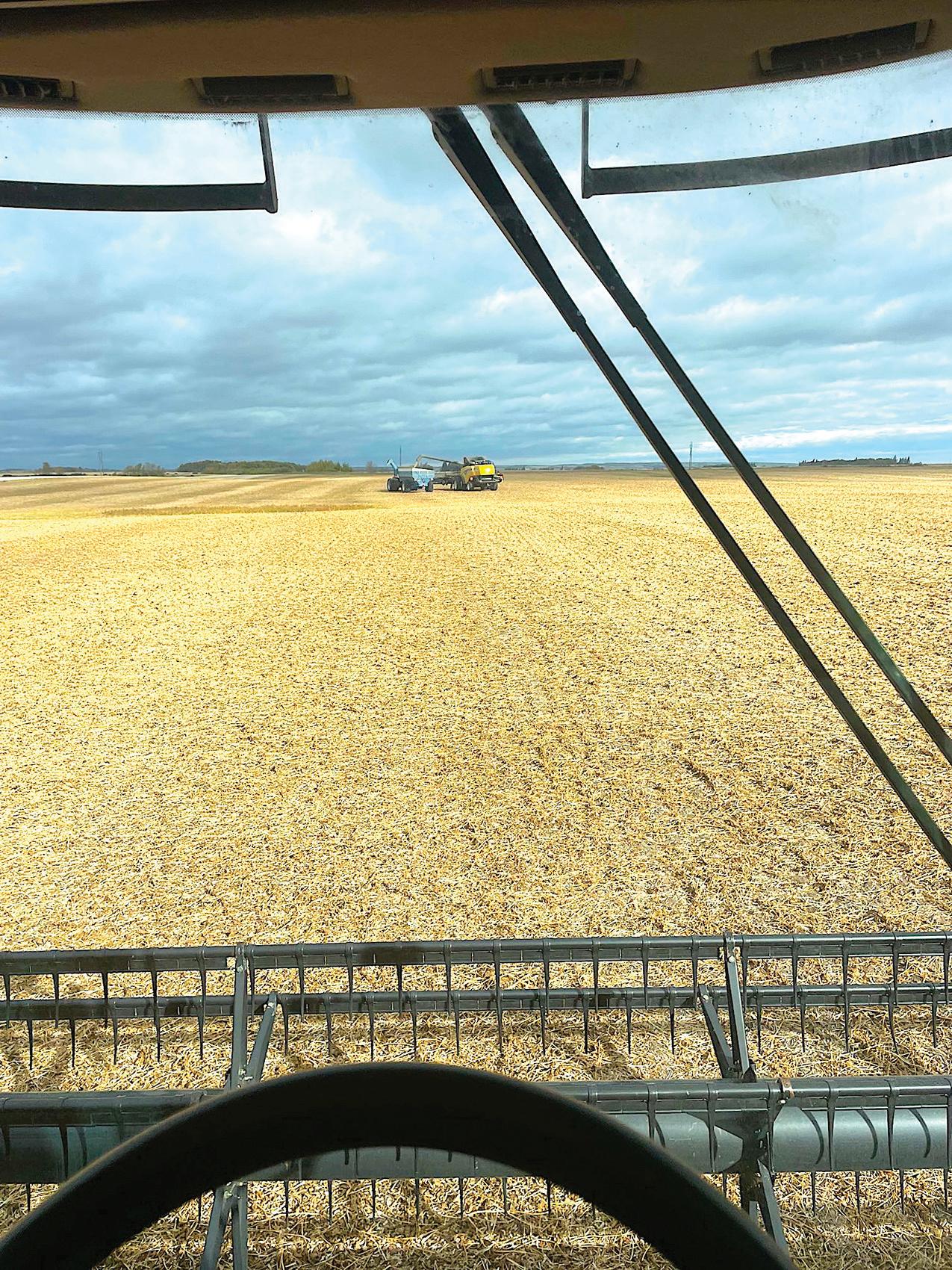
By Harry Siemens
Manitoba and western Canada farmers shared their harvest progress and the impact of recent windstorms through a survey on X for October 5, 2024. Responses highlight the varying stages of harvest completion, with many producers reporting some delays due to high winds that swept through the region. While some areas have finished the season, others are still work-
ing to bring in their crops. This input from farmers provides a real-time snapshot of the challenges they face as they balance the unpredictability of the weather with the need to get their crops off the fields.
Paul Robertson, a food producer at Neepawa, MB, shelled a few soybeans. The odd pod fell to the ground, but the rest went in the bin.
Korey Peters of Randolph,

saying, “We are done except for corn, which won’t be ready for at least a few weeks. It was a very wet start to the year so we couldn’t plant everything, but what went in turned out okay.”
Günter Jochum at Elie, MB wrapped up selective fall work this past Monday [September 30] and is working on surface drainage.
Brendan Uruski of Zbaraz, Manitoba, finished the harvest up there reporting that the last big winds definitely took a little canola yield off the already terrible canola yield.
MB, recently had an interesting survey on X. Hofford asked farmers whether they were loyal to a specific grain company even if their price was slightly lower. Or, the company with the best price gets grain.
The poll results are interesting with 81.5% of respondents who said no, indicating they prioritize the best price. In comparison, 18.5% said yes, showing that some still value loyalty enough to accept a lower price.
MB, said the harvest is going well, “Thanks to a wet spring, harvest is a bit spread out this year. We still have a bit of late canola and soybeans to go. We will start corn late next week [October 7]. There has been no damage from wind that I’ve seen.”
Scott Rempel of Niverville reported, “We are ready to start corn on Monday, so we are in the home stretch.”
Kurt Shmon, owner of Im-

perial Seed in Winnipeg, said alfalfa, red clover, and some alsike clover remain in the fields in the industry. “This is very good progress for this time of year. Farmers in southern Alberta had mostly finished, with 50% done in Saskatchewan and 75% done in Manitoba. Again, in our crops.”
Manitoba farmer and food producer Kurt Klimpke had 40 acres left of soybeans for the 2024 harvest and didn’t notice any wind damage.
Ken Foster of Arberg, MB, had some spring seeding issues because of too much rain
Another Manitoba farmer said, “That big wind we had during the week of September 30 knocked our canola back about 10 bushels an acre. But at the end of the day, we had a good crop. We finished threshing last evening [October 5].”
A Davidson, Saskatchewan farmer, Rob Stone, said, “It’s all done except for a few spots we cut around. I can see some wind damage in those today. I’m glad we don’t have anything of significance remaining.”
Kotylak @Kotyjo, who farms in east Saskatchewan, said, “Some pods have dropped, and we have seven quarters left to go. Most canola is just finished or will be in a week. Ugly out today.”
Ryan Hofford of Bowsman,
It’s interesting to see that loyalty and having a solid comfort level with an agent or manager might be becoming a thing of the past. More farmers are driven by maximizing profitability, which makes some wonder how much the relationships built over time still play a role in these decisions.
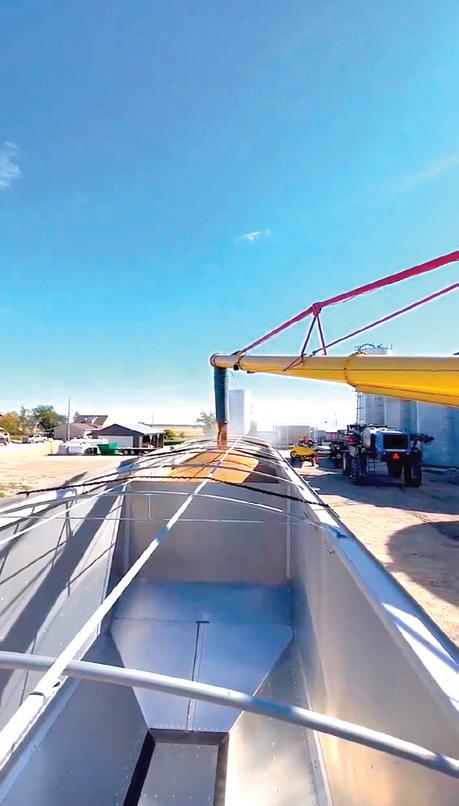
“Wheat
By Elmer Heinrichs
The HyLife dream started 30 years ago when in 1994 four pig farmers from the Steinbach area, Don Janzen and brothers Paul, Dennis and Claude Vielfaure created VL4/Janzen, a company focused on creating the most efficient and integrated operating structure to produced hogs.
By 2002, the business had changed its name to Hytek and purchased a genetics
company, triggering construction of multiplication barns in Canada and the United States.
Six years later it purchased a meat processing plant name Springhill Farms in Neepawa, a large step toward becoming a fully integrated pork company selling products worldwide.
Today, HyLife has full control over its operations, which include feed production, raising animals, trans-

portation, processing, marketing and distribution. It produces 3.6 million hogs annually and processes 3.8 million. Its products and livestock are exported to more than 20 countries and the company’s gross annual revenue is $1.5 billion.
Earlier this year HyLife celebrated the grand opening of its new, nearly 50,000square-foot headquarters in Steinbach.
At the time HyLife president and CEO Grant Lazaruk said “this is more than a building; it is a new home and anchor for HyLife that we hope will become a community landmark. After several years envisioning, planning and building, we look forward to settling in and collaborating in this worldclass space.”
There are roughly 175 employees working in the new headquarters, in logistics, animal health, technical support and human resources.
By Harry Siemens
Dennis Lange, pulse and soybean specialist with Manitoba Agriculture provided an update on the current harvest status in Manitoba. He said that yields for pulse and soybeans have been promising, with an average expected to be between 40 and 45 bushels per acre across the province. In the central region, soybean yields have been excellent, ranging from 45 to 60 bushels per acre.
Lange stated that the overall quality of the crops has been good, with no issues related to frost. While facing some quality concerns due to wet weather in early September, dry bean yields have exceeded expectations and remain marketable.
As for harvest progress, Lange said that most areas are nearing completion. The Interlake region, which experienced delays due to rainfall and late seeding, is about 88 percent complete. In comparison, the northwest region is around 86 percent complete. Despite some variability, Lange noted that wheat protein content was good, and no significant issues arose with the harvest overall.
He said that the weather forecast looked favourable, and barring any unfore-
Corn harvest has begun in the Central and Eastern regions. Most farmers are progressing on fall fieldwork, including tillage, ditching, and ongoing herbicide and fertilizer applications.
For cereals, spring wheat harvest is complete in most regions, with yields ranging from 40 to 95 bu/acre and protein levels between 10% and 15%. Oat yields are estimated between 110 and 180 bu/acre, while barley yields range from 80 to 120 bu/acre. Corn harvest has started, with early yield reports ranging from 140 to 240 bu/acre. The canola harvest is 98% completion, with yields between 25 and 65 bu/ acre and averages from 30 to 45 bu/acre. Flax harvest is 89% complete, with yields between 20 and 40 bu/acre. Sunflower harvest has started in the Central region, with 35% complete and preliminary yields of black oilseed sunflowers around 2,200 lbs/acre.
The dry bean harvest is 99% complete, with average yields between 1,700 and 2,000 lbs/acre. Soybean harvest is ongoing, with yields ranging from 35 to 60 bu/acre and an average of 40 to 45 bu/acre. Corn silage harvest is complete in Eastern Manitoba, and beef producers are finishing up the remaining tame and native hayfields. Corn silage harvest in the province is approximately 75% complete, with dryland yields between 6 to 10 tonnes. Alfalfa remains in good condition, with plenty of green material for overwintering.
Cattle herds are going off to pasture, with some herds
moved to stockpiled forages or fall grazing sites. Cattle roundup has begun, with calves being weaned, sold, or backgrounded. Producers feed the cattle with hay on pasture or stockpiled fields, and manure spreads as they clean the corrals. Dugouts are mostly full.
By region, in the Southwest, 90% to 95% of the harvest is finished, with canola and soybeans almost done, yielding between 30 and 45 bushels per acre. Corn harvest is about halfway complete, while sunflower and flax harvests have also begun. Spring wheat is almost done in the Northwest, with yields averaging 65 to 70 bushels per acre. At the same time, canola is 92% finished, though with lower-than-usual yields of 30 to 40 bushels per acre. Soybean harvest is 85% complete in the region, with yields ranging from 35 to 55 bushels per acre.
In the Central region, harvest has progressed well due to dry weather, with soybeans and dry beans almost fully harvested. Soybean yields averaged 45 bushels per acre, while dry beans yield between 1,700 and 2,000 pounds per acre. Canola and corn are also nearly complete, with corn yielding between 140 and 240 bushels per acre.
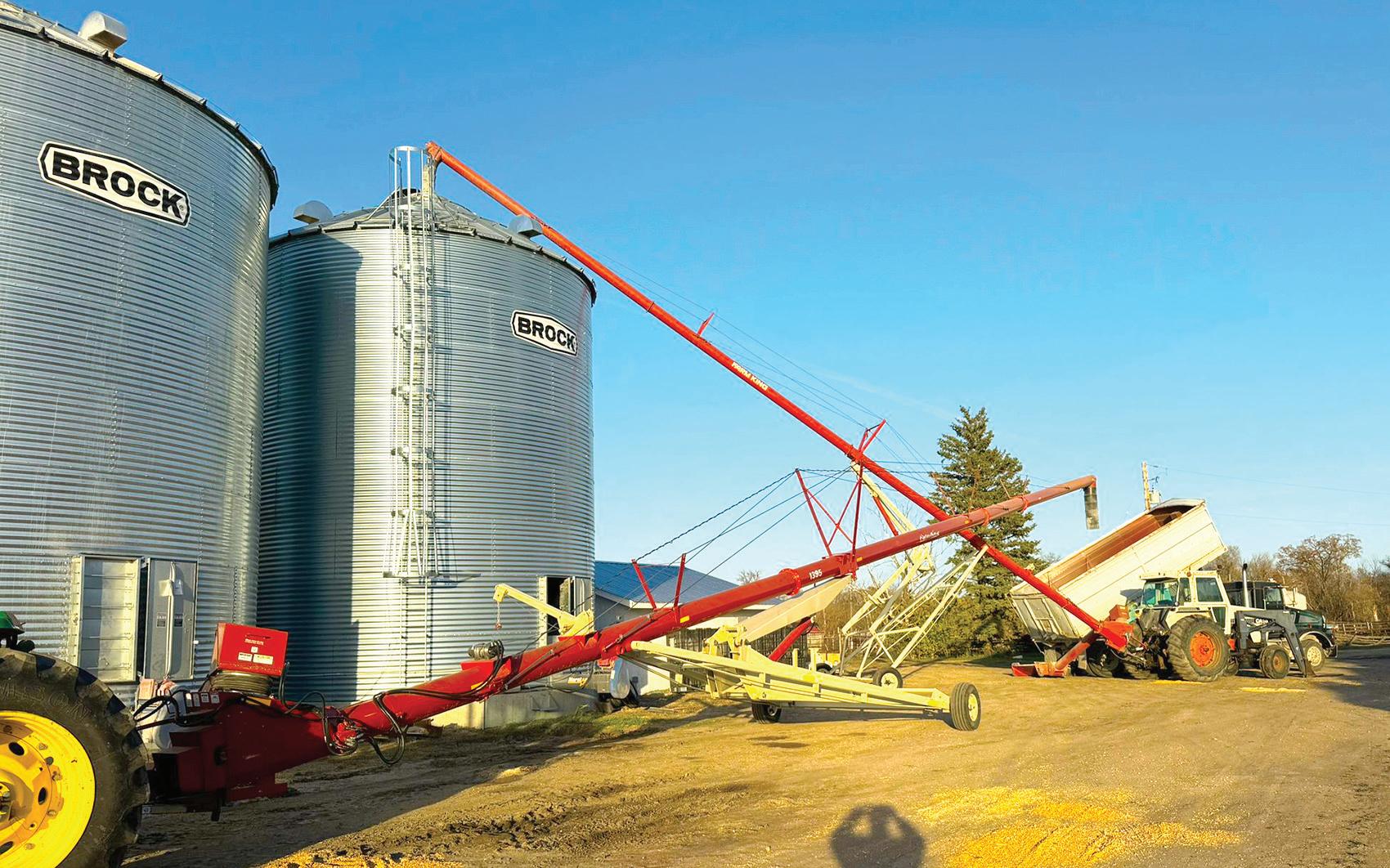
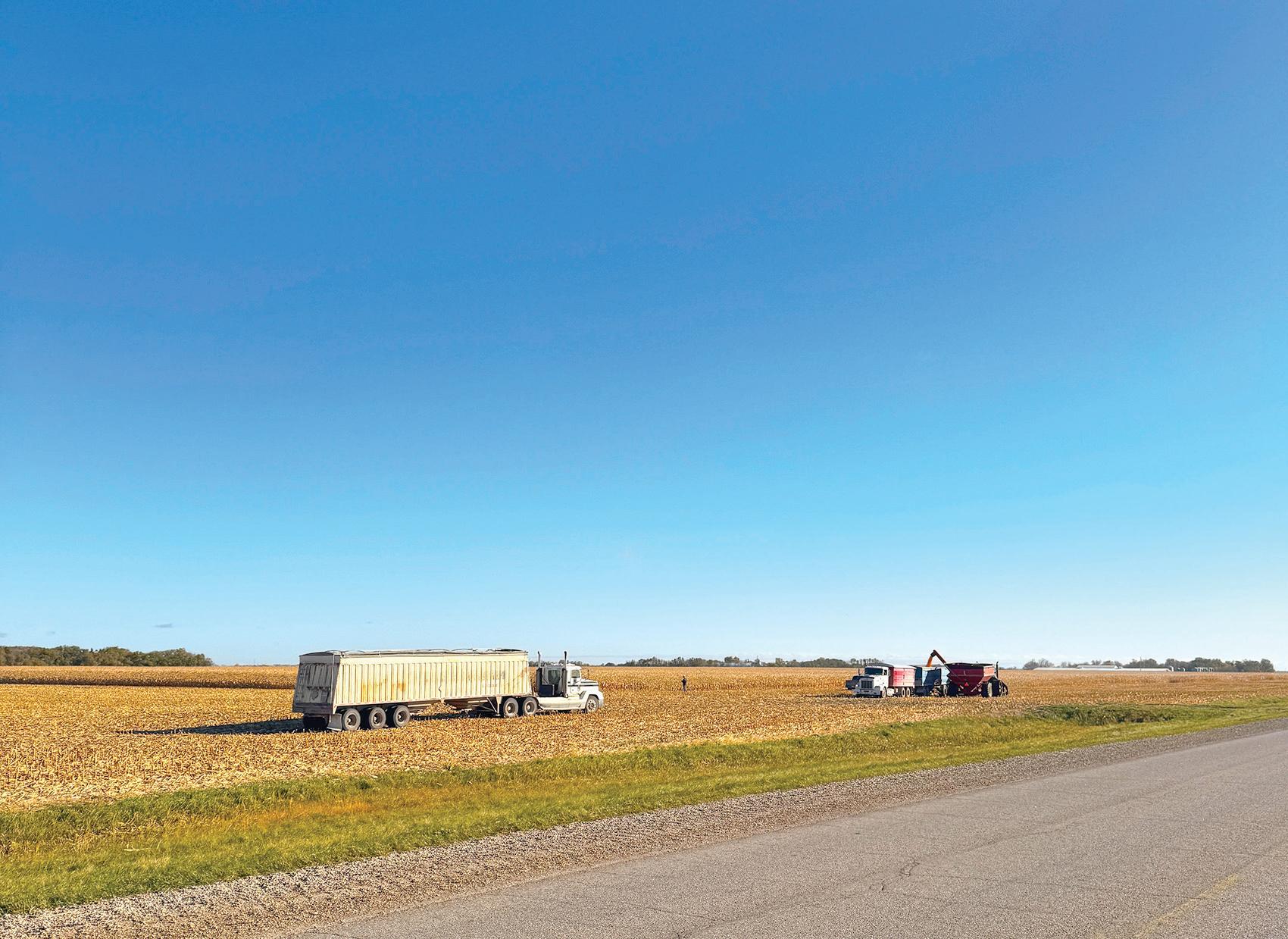
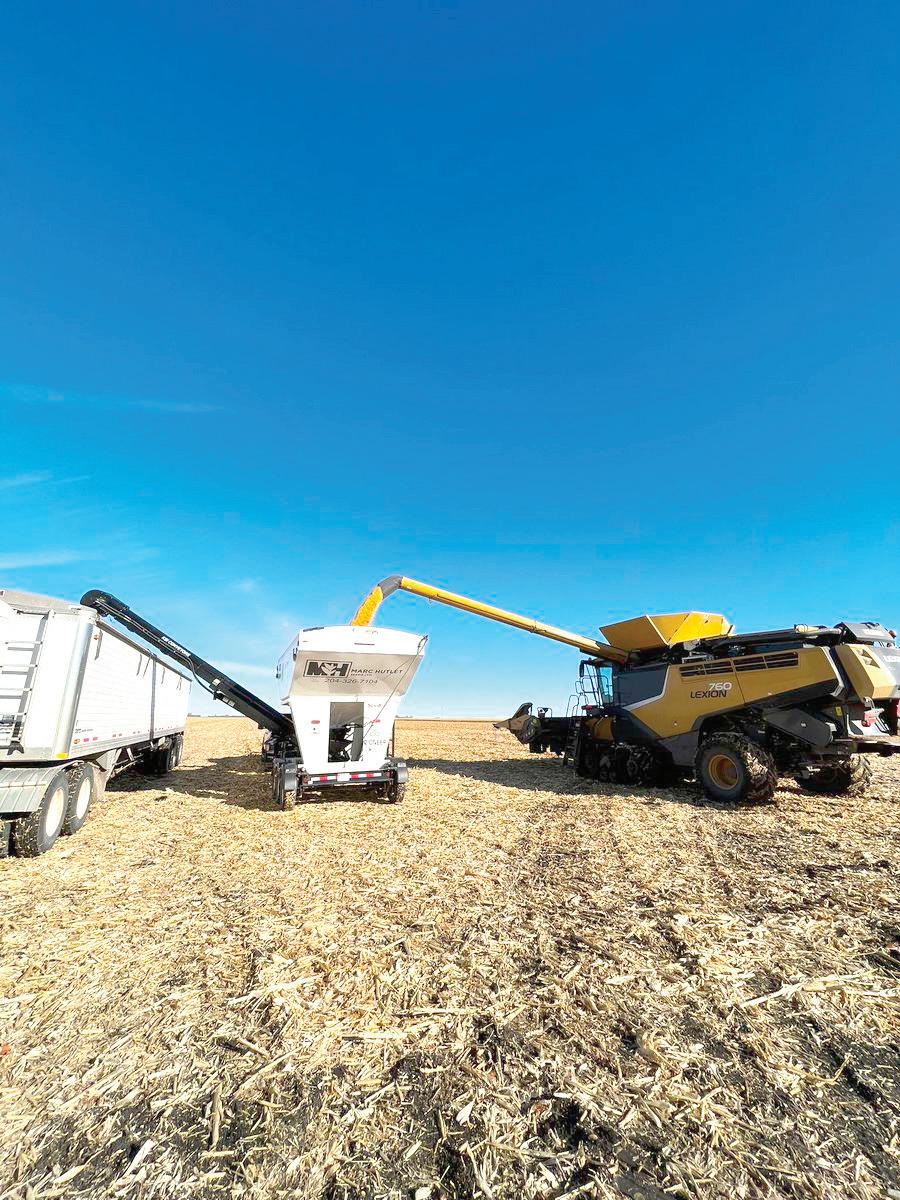
In the Eastern region, corn is harvested 45% with yields between 120 and 170 bushels per acre. Soybeans are 85% done, averaging 43 bushels per acre. The Interlake region reports similar progress, with canola and soybean harvests almost finished and corn, sunflower, and flax harvests well underway.




By Harry Siemens
The cross-party display of support for Bill C-282, an Act to amend the Department of Foreign Affairs, Trade and Development Act (supply management) at the rally on Parliament Hill on October 11, 2024, has left the beef and cattle sector who oppose the Bill disappointed.
Heath MacDonald, an MP from Prince Edward Island, said on X that he joined colleagues from the Liberal, NDP, BQ, and Green caucuses on Parliament Hill at a rally supporting Bill C-282 to protect supply management.
MacDonald’s participation highlights the widespread political support for Bill C-282, with representatives from multiple parties rallying behind the protection of supply management systems in Canada’s dairy, poultry, and egg sectors. However, this support has sparked concern from other sectors, particularly the beef and cattle industry, which views the bill as a potential threat to Canada’s broader trade relationships and export-driven agricultural sectors.
In opposition, the beef sector statement said the public endorsement of the bill by the current and former federal Minister of Agriculture and Agri-Food is especially disheartening, as it appears to prioritize one sector - supply management - at the expense of the majority of Canada’s agri-food industry and the export-dependent sectors critical to the country’s economy.
International trade forms the backbone of the Canadian economy. This trade represents twothirds of economic activity and supports one in six jobs nationwide.
According to opponents, Bill C282 poses a threat to Canada’s vital trade relationships by limiting the country’s ability to negotiate future agreements freely.
“This would set a dangerous precedent that could harm Canada’s reputation as a reliable free trade partner,” stated Nathan Phinney President of the Canadian Cattle Association.
If passed, Bill C-282 binds future negotiators before international
trade talks begin.
The Canadian Cattle Association said this encourages protectionist demands from other sectors and potentially leads to less ambitious trade deals. This scenario places Canada’s key industries, especially those dependent on exports like the beef and cattle sector at serious risk. Canadian beef producers, who export roughly half of their produce, are particularly vulnerable. Canada, one of the world’s most sustainable and efficient beef producers, is well-positioned to meet the growing global demand for protein. However, Bill C-282 threatens to jeopardize this potential and undermine critical trade relationships, particularly with partners such as the United States.
The Canadian Cattle Association expressed hope that Canada’s non-partisan upper chamber would recognize it as bad policy and a bad deal for Canada. The association said this unwavering defence of the supply management system, which underpins Bill C-282, should not be pursued at the expense of other vital trade-
dependent sectors of the Canadian economy.
The Association went on to say, that amending the Department of Foreign Affairs, Trade and Development Act this way would be an internationally unprecedented protectionist move. Future governments must keep all options open to secure the most meaningful and robust trade agreements possible.
Bill C-282 is not a referendum on supply management; the government and the public should not treat it as such.
“We continue to urge policymakers to oppose Bill C-282 strongly,” said the Canadian Cattle Association.
Signatories in opposition include: Matthew Atkinson, president of Manitoba Beef Producers; Werner Stump, president of British Columbia Cattlemen’s Association; Brodie Haugan, chair of Alberta Beef Producers; Keith Day, chair of Saskatchewan Cattlemen’s Association, Craig McLaughlin, president of Beef Farmers of Ontario; Trevor Welch, chair of New Brunswick Cattle Producers.
By Harry Siemens
Dan Mazier, MP for DauphinSwan River-Neepawa and Shadow Minister of Rural Economic Development & Connectivity started his day recently in Oak River, MB, where he met with a group of landowners who are voicing deep concerns about the environmental policies pushed by Trudeau’s Environment Minister.
Posting on X, Mazier said these landowners fear that the minister’s radical policies, particularly surrounding ecological corridors and other initiatives, threaten their livelihoods and the rural way of life they have worked hard to maintain.
Mazier, a former KAP President and current Vice-Chair of the Standing Committee on Environment listened intently to their concerns and pledged to take these issues back to Ottawa, emphasizing the disconnect between Ottawa’s policies and the realities faced by rural Canadians.
“Minister Steven Guilbeault, the Minister of Environment and Climate Change in Canada, has no understanding of life in rural Canada, yet he continues to impose policies that suggest otherwise,” wrote Mazier.
His so-called environmental initiatives are not only disconnected from the realities of rural life but are actively harming the
very communities that rural Canadians depend on for their way of life. Landowners in Oak River expressed their frustration and fear that these policies are leading to significant damage to their communities, a concern that MP Dan Mazier echoed in his commitment to address these issues in Ottawa.
Local residents raised several valid concerns about Guilbeault’s ecological corridor program and other policies threatening Canadian agriculture. Farmers and ranchers emphasized that they are the best stewards of the land, managing it more effectively than any external policies could dictate.
Residents stressed that Guilbeault needs to stop imposing “Ottawaknows-best” policies on Canadians, particularly those that impact rural communities and agriculture. MP Dan Mazier assured the group that he would take these concerns back to Ottawa, advocating for their voices.
A group of landowners from the Oak River, MB, area has voiced serious concerns regarding the federal government’s ecological corridor program.
They shared a definition and purpose of ecological corridors as outlined by the government: An ecological corridor is a, “Clearly defined geographical space where governance, management, and stewardship over the long term
maintain or restore effective ecological connectivity while upholding Indigenous stewardship values.” (modified from IUCN, 2020).
The primary goal is to connect protected and conserved areas with unprotected natural habitats, ensuring ecological networks that work in tandem with protected areas and other conservation measures (OECMS). However, these landowners fear these corridors’ impact on Canadian agriculture and rural livelihoods.
Several of the landowners reviewed the details of the program. It noted that it implies liability if actions within the corridor go against its regulations. The group shared this sentiment, as they interpreted the program to hold landowners accountable for any non-compliant activities within the designated corridors.
A group of landowners discussed the involvement of their local Conservation District, part of the West Watershed District, in supporting the ecological corridor initiative. The district manager approached municipal councils to gather letters of support for the program, presenting it as a grant opportunity. However, the information provided was vague, and there was no mention of Parks Canada, leading the councils to believe it was an innocent funding offer. The

grant amount, spread across 14 municipalities, was minimal. As word spread among local councillors and residents, many began questioning the initiative, realizing that an ecological corridor could be more invasive than initially thought, potentially impacting the region’s agricultural lifestyle.
Then, just before writing this article, another note came in.
Regarding the Ecological Corridor Program, the Assiniboine West Watershed District has received notification from Parks Canada that the Ecological Corridor project application is up for a funding recommendation. A draft Contribution Agreement arrived, and plans are moving forward to review it with municipal officials, First Nations representatives, and concerned citizens. The goal is to address some concerns and gather support for the landowner opportunity.



By Joan Airey
September 28 Virden Agricultural Society Fairgrounds was the site of the third annual Black Gold Classic fall cattle show for all breeds.
Great weather greeted spectators and exhibitors to the show. The Black Gold Classic Committee is made up of Cody Renz, Naomi Best, Amanda Scott, Everett More, Greg Tough, Ashlee Mitchell and Trevor Nolan. Judges for the day were Terrance Vodon (Virden), Ty Nykolation (Crandall), and Kolton McIntosh (Ericksdale).
“Three years ago, we were sitting visiting after the cattle show in Oak Lake.
Cody Renz and I decided we needed a fall cattle show in Virden. Facilities were there and if you don’t use them, they plunge into disrepair. We felt a show
ett More. “I phoned a few people to join the committee and it’s working really well. The local business community has given us phenomenal support allowing us to organize the show and we receive lots of positive feedback from exhibitors. The first year we had seventy entries now it’s at least a hundred head.”
There were forty-seven heifer calves in the heifer calf class which were split into seven classes. Champion Heifer was owned by Freyburn Farms-Freyburn Blackbird 36M and Reserve Champion owned by Horner Cattle CompanyHFL Rose 4034M.
There were sixteen bred heifers in the bred heifer class. Champion was owned by Swindon Ranch -Seldom Rest Sandy 3031. Reserve Champion was owned by Northern Light Simmentals- Brooksland Lainey 313L.
Futurity Bred Heifers had six entries (they had to be shown as calves) with Champion Futurity Bred Heifer owned by Freyburn Farms- Feyburn Rally Missie 22L. The Reserve Champion was owned by More Bros SimmentalsMore’s Ms. Laya 22L.
Champion Futurity Cow/ Calf Pairs was owned by More Bros Simmentals - More’s Ms. Karma 203K and More’s Marshall 402M. Reserve Champion was Gurr’s Simmentals
-Gurr’s Miss Kansas 3K and Gurr’s Mr. Maverick 3M (to be in the Futurity Cow/Calf pair they can to have been shown as a calf and bred heifer at the Black Gold Classic).
The bull class had thirtysix entries. Champion bull was owned by HTA Charolais -HTA Excalibur 449M. Reserve Champion was owned by Horner Cattle Company- HFL Longview Long Shot ET 4074M.
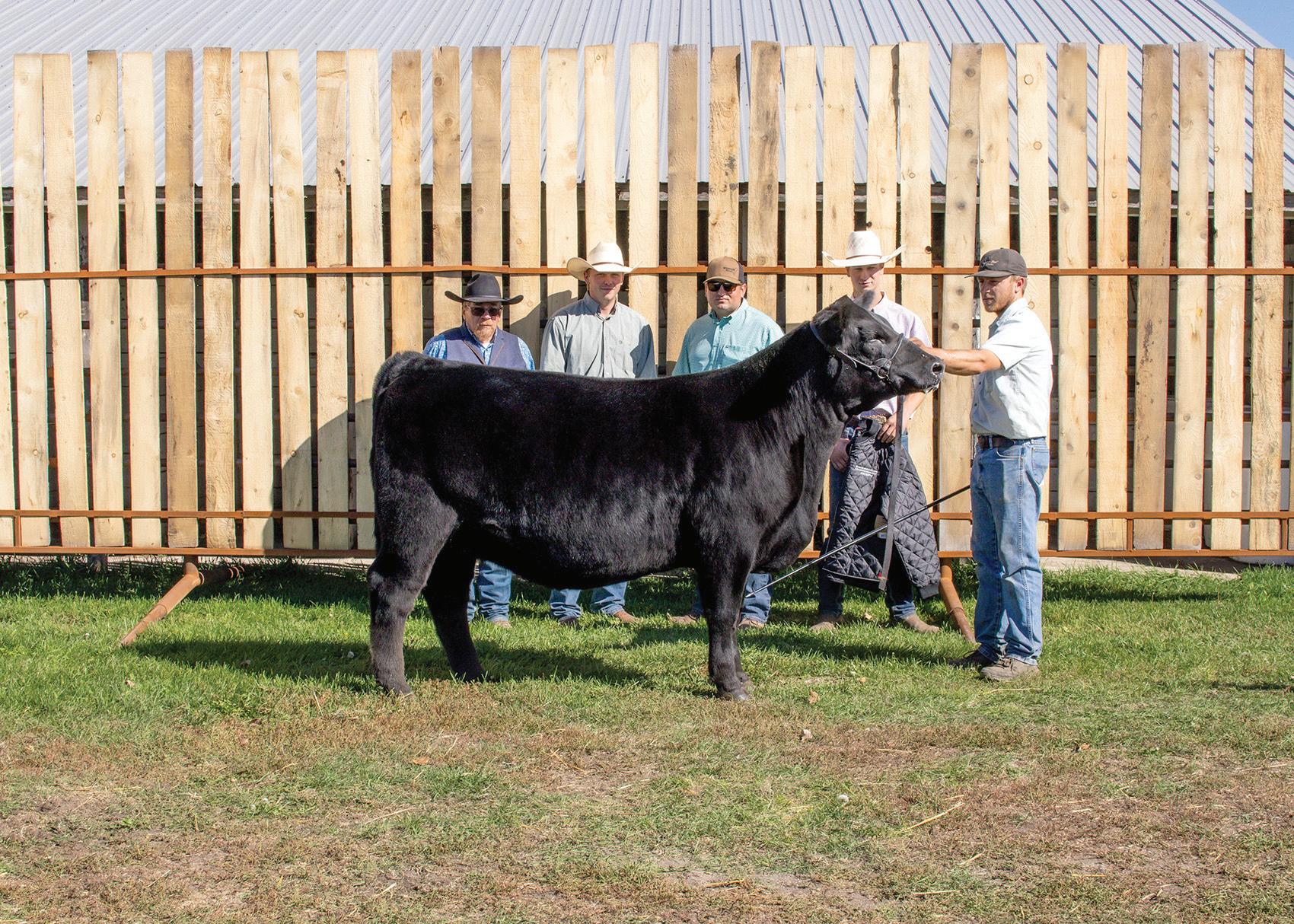
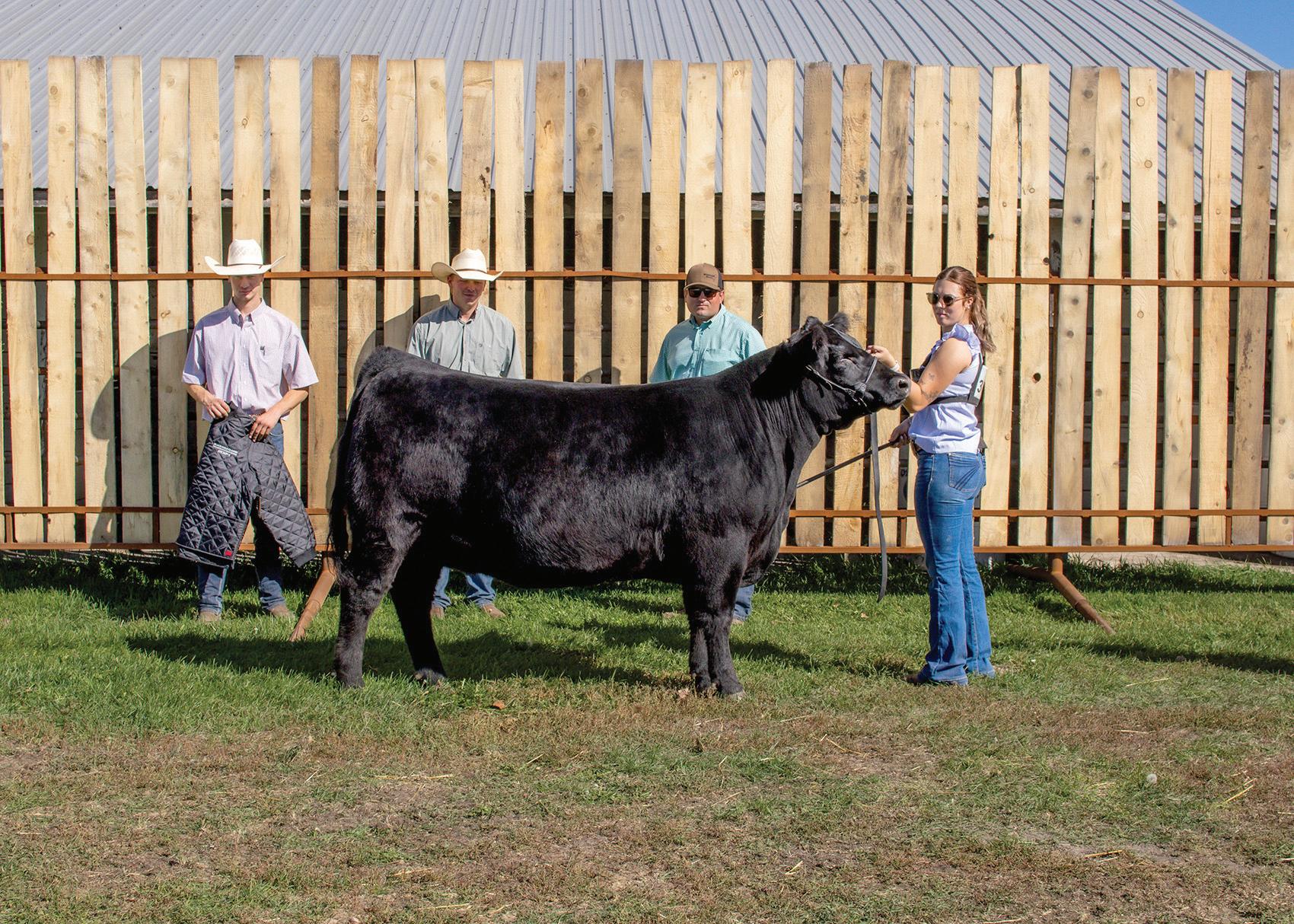
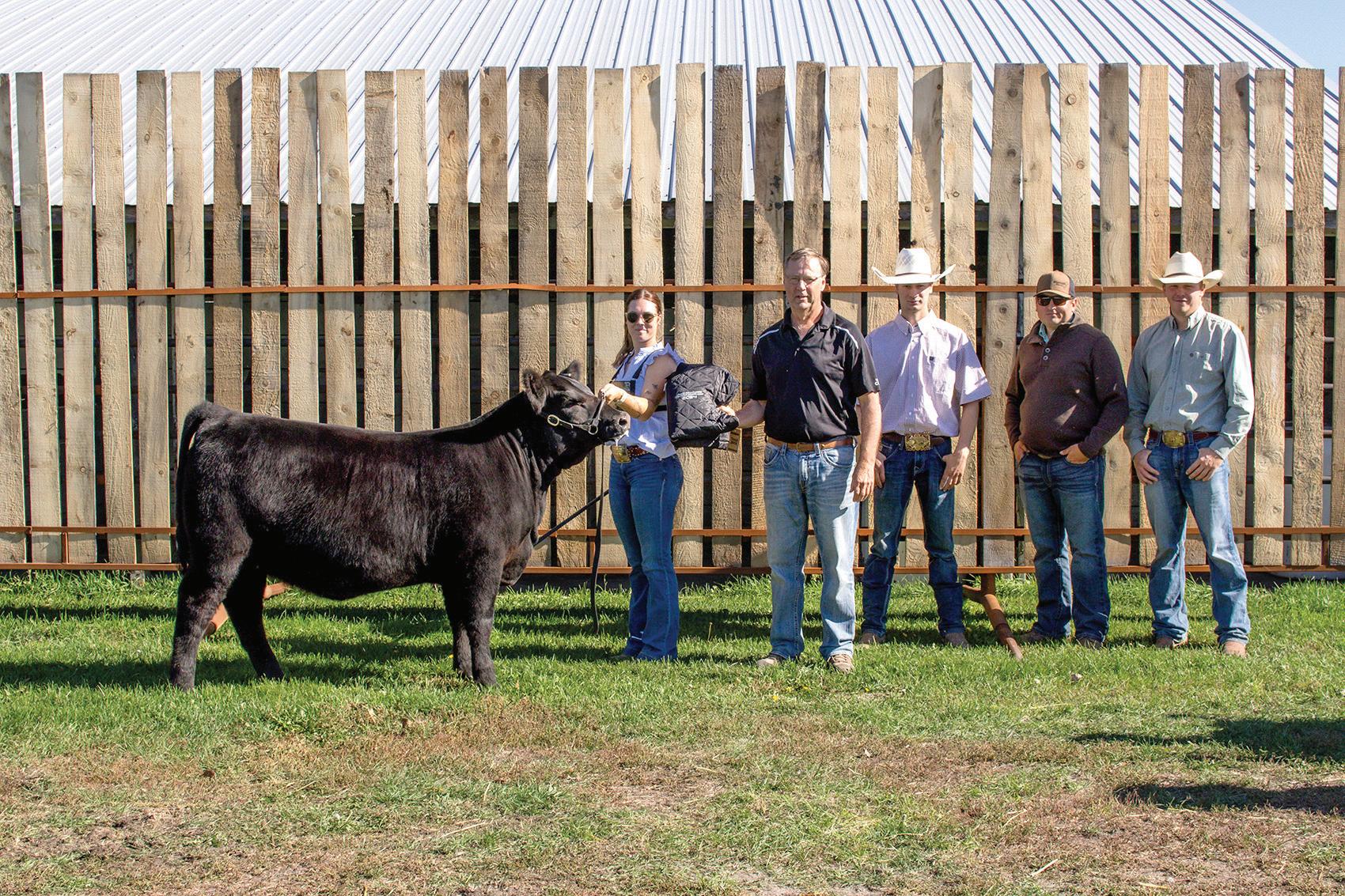
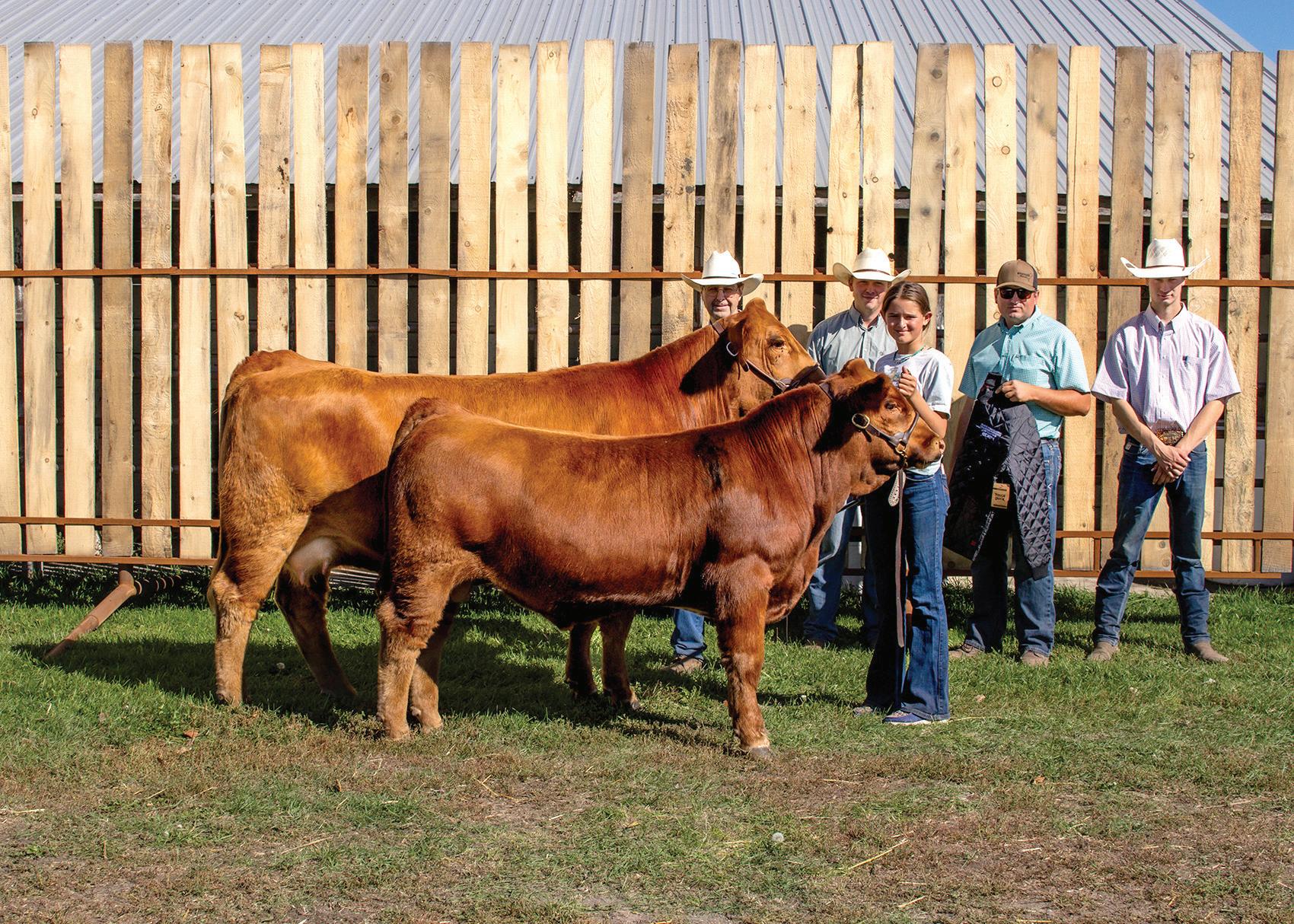
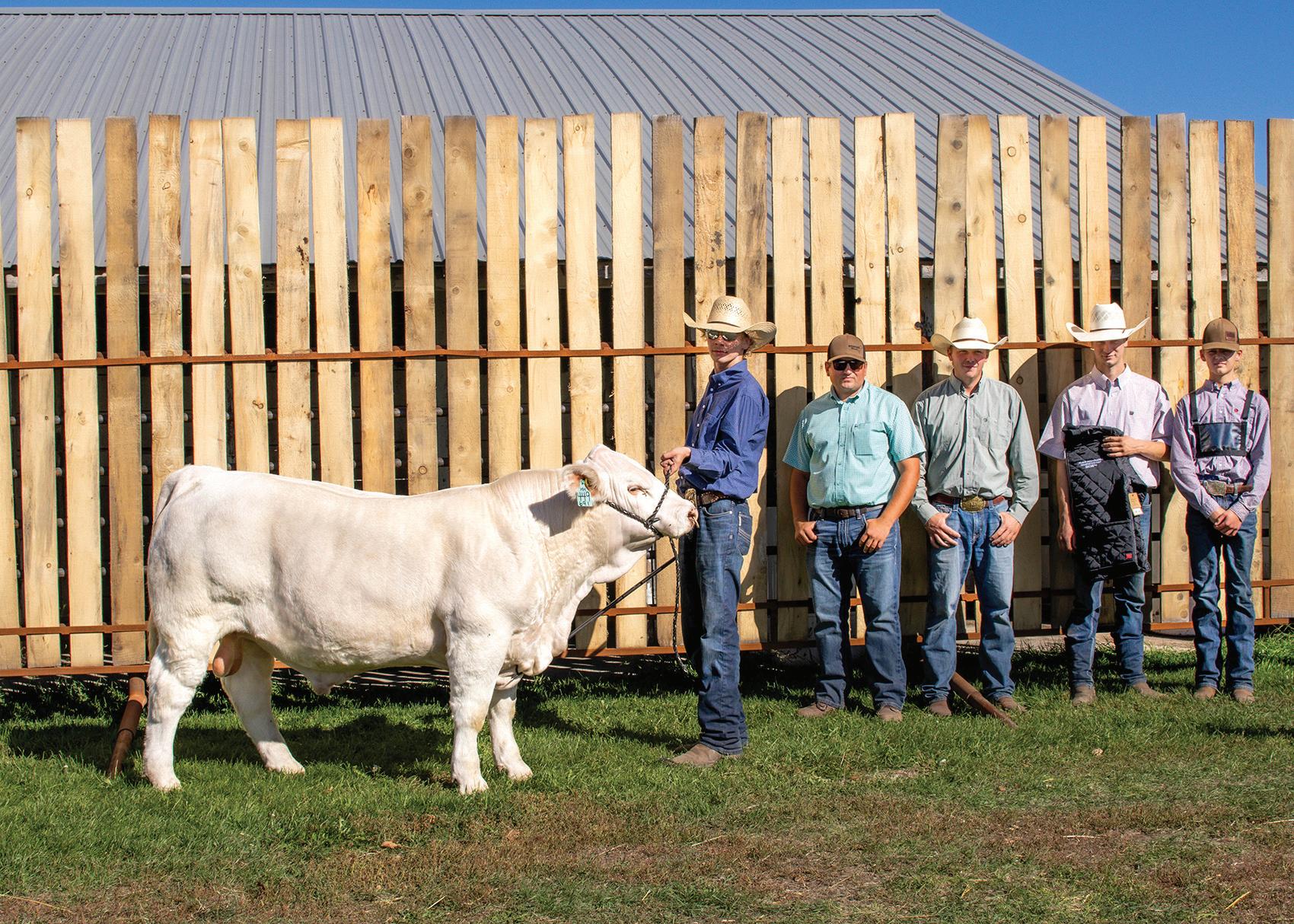
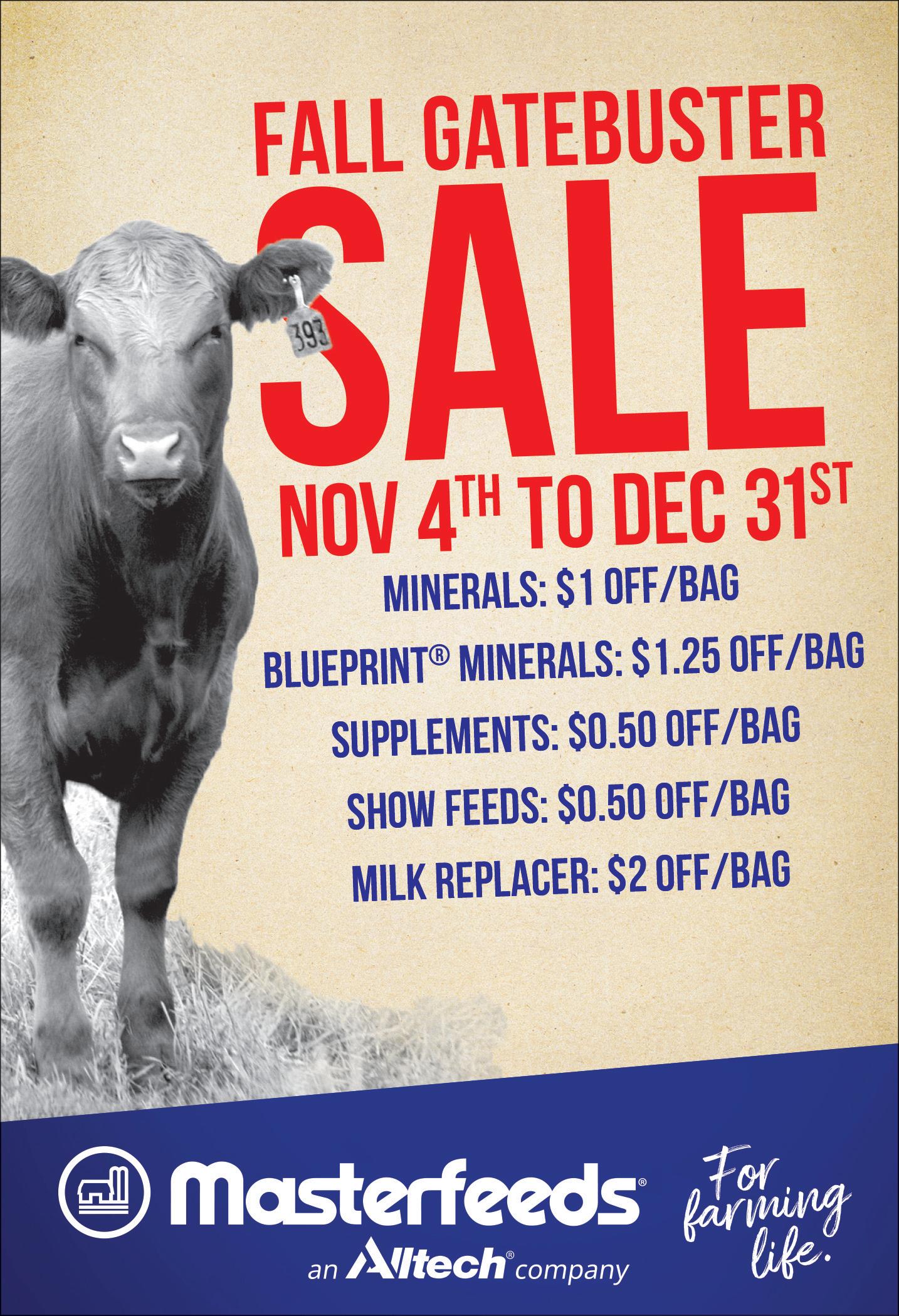


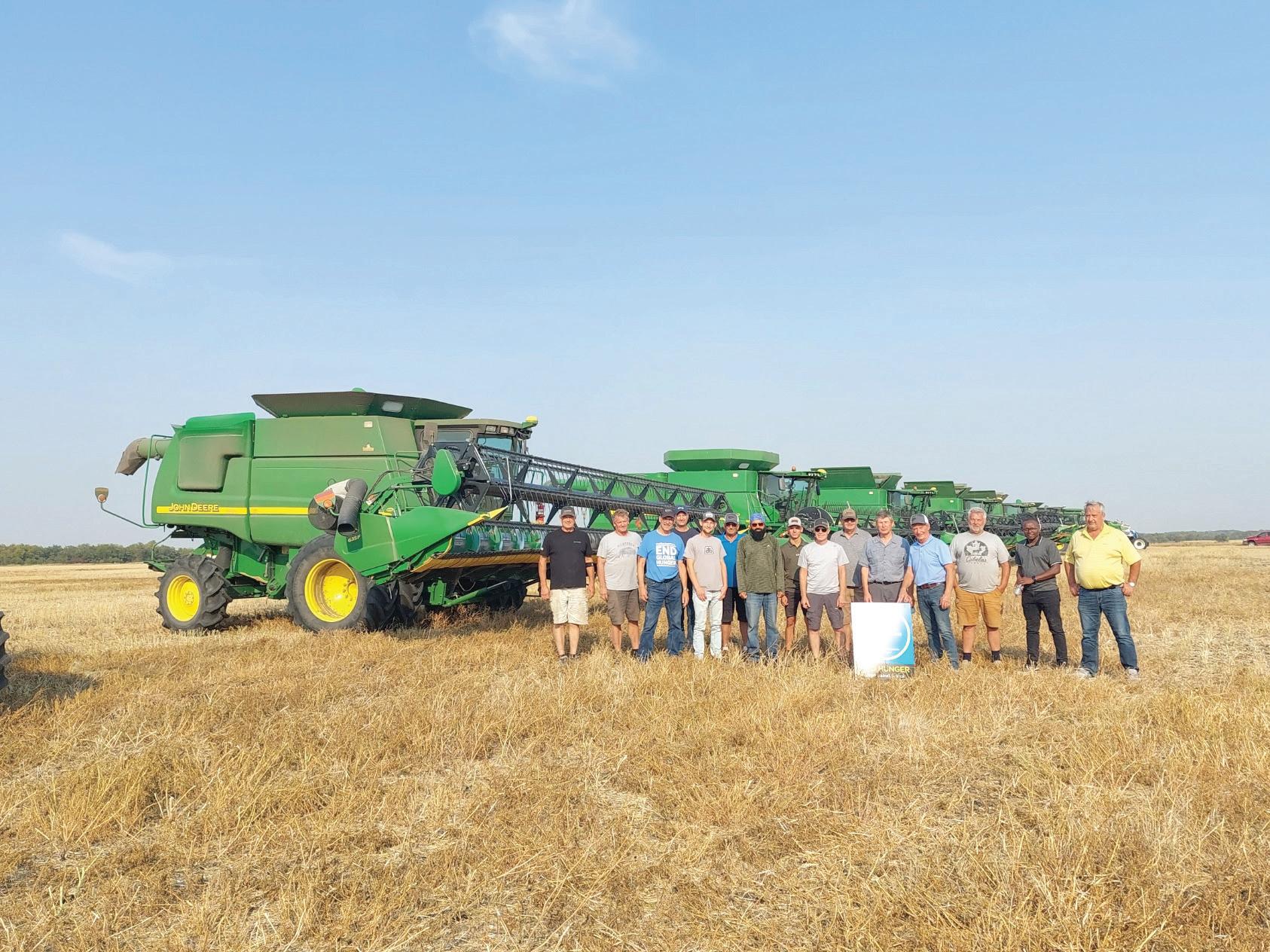
By Elmer Heinrichs
Canadian Foodgrains Bank (CFB).
As the days got shorter and cooler in September, many crops were being harvested during the beautiful autumn season. The month was a busy time for farmers but all the growing project crops are completed, says Janzen.
“The Landmark growing project on August 20 was the first harvest event I attended, and then I went to four more in August and another 13 in September. Mid-September was a particularly busy harvest time in which I got to 11 harvests events during an eight-day period,” said Janzen. “Besides those harvest events, I count at least 17 other growing projects that harvested their project on their own. While com-
modity prices are down from previous years, most growing projects report good to excellent crop yields.”
Colleagues from our Winnipeg CFB office said, “How inspiring it is to see rural and farm communities’ work together to support the Foodgrains Bank in its work to alleviate hunger,” added Janzen. “We had 41 growing projects across Manitoba raising a crop and funds for the Foodgrains Bank.”
He notes that while most gather together to harvest, others have community fields and now commit to getting together after harvest to gather individual donations.
“It’s been a good growing season for most farmers, things seem to be going well and I’m just always grateful for what I call a network of generosity among the communities that support the Foodgrains Bank and its

just really encouraging to see people looking beyond themselves,” he said.
As coordinator, “I thank them and also to remind them of ongoing needs and opportunities that we have to support others,” added Janzen.
All supporters of the Foodgrains Bank including growing project volunteers, business supporters and individual supporters are invited to join Foodgrains staff for an evening of food at Thun-
der Bay, Randolph, Portage la Prairie, Oakbank or Arnaud.
Janzen said two excellent choirs will bring “Singin’ in the Grain” concerts – the Eastman Male Choir and the Faith and Life Male Choir.
Supporters are encouraged to come for these fund-raising concerts at Emmanuel Mennonite Church in Winkler on October 26 or to Douglas Mennonite Church in Winnipeg October 27.
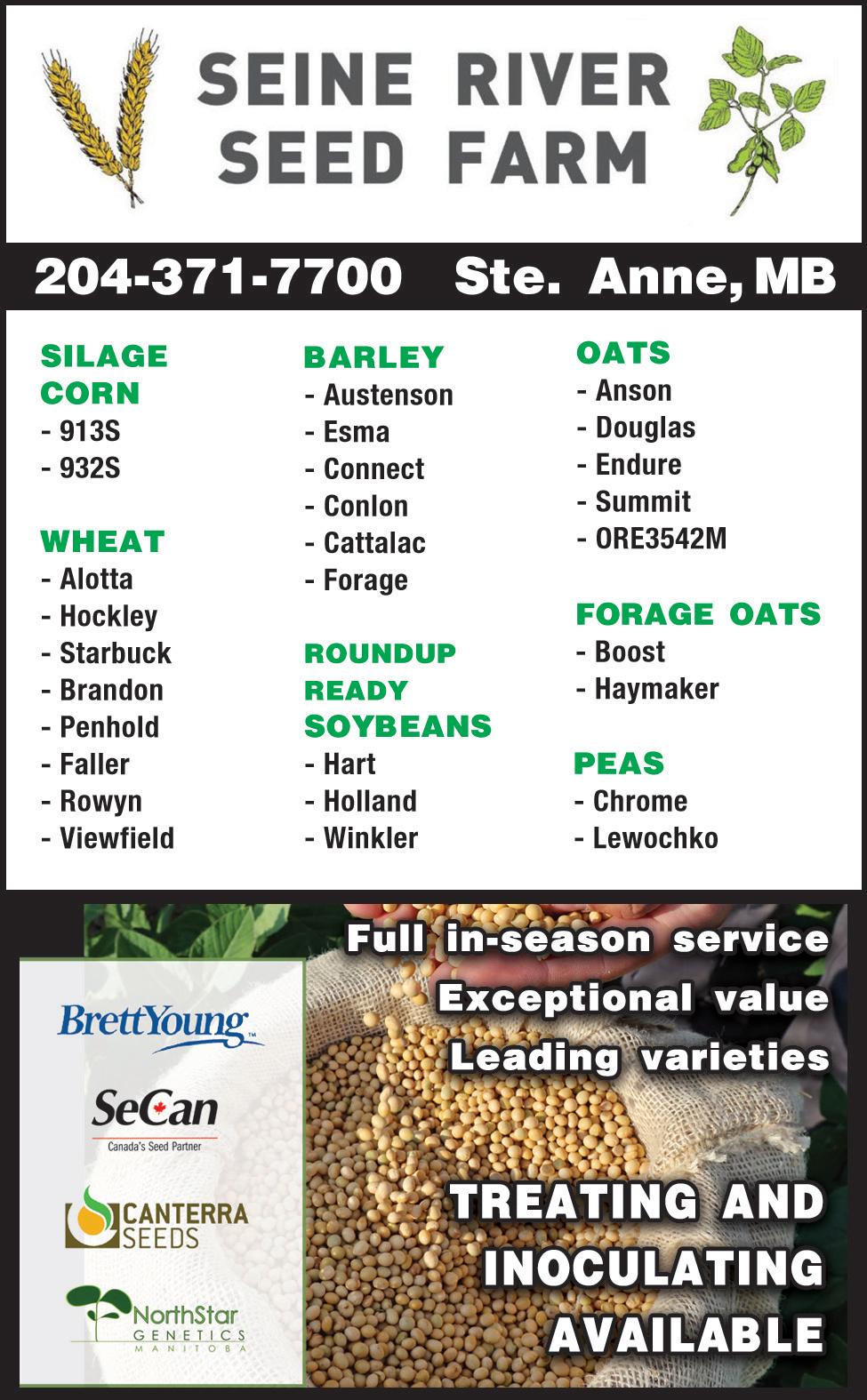
By Elmer Heinrichs
Fall and harvest time often remind us of our province’s rich farming history through the time that people of many nationalities settled here over the last century.
Much has happened in that time and many may not know that Niverville was home to the very first grain elevator in Western Canada, built in 1879 by William Hespeler, who served as an immigration and agriculture agent for Manitoba and later as the MLA for Rosenfeld, and as Speaker in the Legislative Assembly.
It was from this great round grain elevator that the first Western Canadian barley was shipped to markets overseas – the start of a significant agricultural industry in Manitoba.
Today, Hespeler Park in Niverville commemorates William Hespeler and his role in the settlement of Western Canada and developing our incredible potential.
Nearby, the Springfield Agricultural Society commemorates pioneering grain growers with a special monument in Dugald, and the first shipment of Western Canadian wheat in October 1876. Purchased at 85 cents per bushel, the wheat was shipped by Red River steamer for use in Ontario as seed.

To support the competitiveness and sustainability of Canadian cereals, the Federal Government recently announced up to $7.3 million in funding to Cereals Canada
through the AgriMarketing Program and the AgriScience Program – Projects Component, two initiatives under the Sustainable Canadian Agricultural Partnership.
Cereals Canada is receiving up to $6,660,817 through the AgriMarketing Program to increase market access, improve customer support, and expand exports through

By Joan Airey
Rivers, Manitoba is home to a new mural recognizing the Ukrainian families who settled there early in the 1900’s in a community hall which now houses a Pentecostal Church and Riverdale Harvest Food Bank.
Mother and daughter team, Mary and Erica Lowe have completed this colourful farm and Ukrainian themed mural.
The Lowes have painted murals in numerous towns throughout Manitoba recording history with their art. You can find their murals in many communities

initiatives like technical exchanges, market research, and knowledge sharing among stakeholders.
Through the AgriScience Program – Projects Component, Cereals Canada is also receiving up to $674,249. This funding will support research on how environmental conditions impact cereal crop quality during the growing season. It will also expand milling expertise, establish oat quality standards, and compare Canadian wheat with international competitors to strengthen Canada’s place in the global market.
“Our cereal farmers are a cornerstone of Canada’s agricultural sector and work so hard to grow top quality grain,” explained Lawrence MacAulay, Minister of Agriculture and Agri-Food.
“With this funding, we’re not only helping them stay competitive, but also mak-
ing sure that Canadian grains continue to meet our high standards here at home and around the world. This vitally important investment will support the growth, sustainability, and future of cereal farming in Canada.”
Cereal crops are a staple of Canada’s agricultural sector. Last year, we exported 29.8 million tonnes of wheat, barley and oats, valued at $13.8 billion and demand continues to grow.
“This funding enables us to amplify our resources, maintain and grow markets, and foster industry relationships and advocacy, helping to ensure the long-term competitiveness and sustainability of Canada’s cereals industry,” noted Dean Dias, CEO, Cereals Canada.
In the last five years, Canada exported wheat to almost 100 countries with some of the largest buyers being in
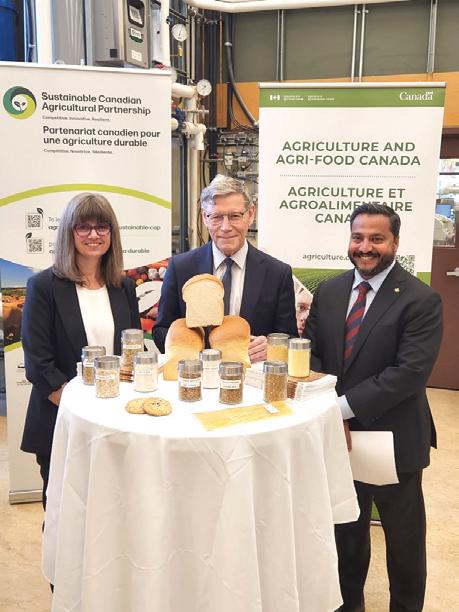
the United States, Indonesia, China and Japan.
According to Statistics Canada, 2023 wheat exports were nearly $12 billion, and 2023 oat exports were $725 million.
Cereals Canada is a national, not-for-profit organization representing the cereal grains sector, focused on enhancing the competitiveness of Canadian cereals both domestically and internationally.
Recently, the Federal Government announced up to $6,828,349 over 5 years to the Organic Federation of Canada (OFC) through the AgriScience Program – Clusters Component, an initiative under the Sustainable Canadian Agricultural Partnership.
Investing in organic farming research is essential for advancing sustainable practices, addressing the sector’s unique challenges, and supporting the continued growth and competitiveness of Canadian organic products.
“The science that supports organic agriculture seeks innovative, ecologically sound solutions to production challenges that can serve all
forms of agriculture,” said Jim Robbins, President of the Organic Federation of Canada. “Maintaining biodiversity and soil health, reducing GHGs, using integrated approaches to pest management, and delivering economic benefits are all factors that guide the 14 research activities in field crops, horticulture and livestock production that will be carried out as part of the Organic Science Cluster 4.”
This funding will allow the OFC to partner on research into the environmental benefits of sustainable farming practices and address challenges such as climate change, biodiversity loss, soil health and
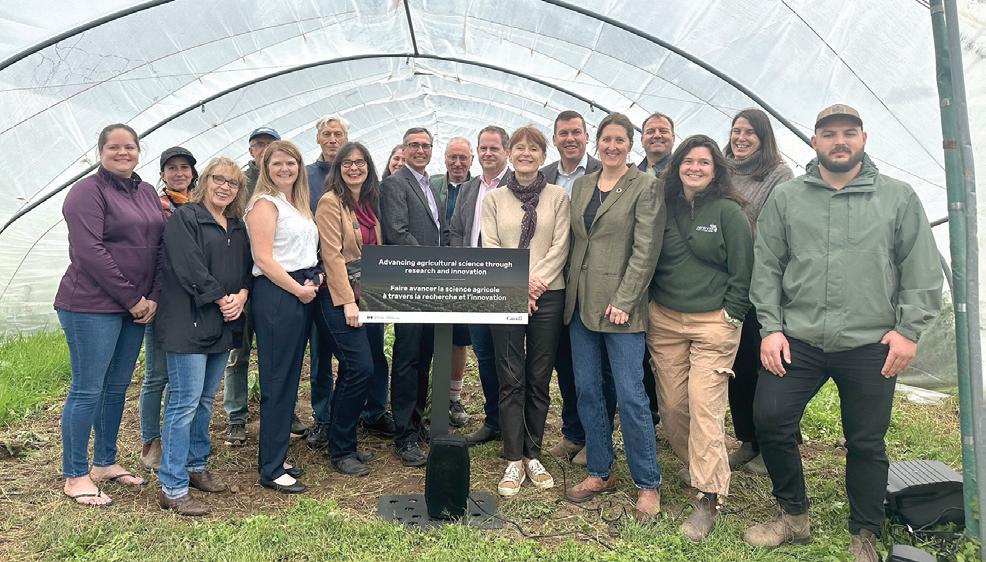
water quality. The OFC will develop solutions to production challenges such as organic crop adaptability and pest management. These efforts will improve the performance of organic production systems, support economic growth and development, and improve sustainability in the sector.
“This investment will help our organic farmers manage environmental challenges and fine-tune their practices so they can keep delivering top-quality food, sustainably,” noted Lawrence MacAulay, Minister of Agriculture and Agri-Food. “Its support like this that allows our organic sector to lead the way and reach even more customers here in Canada and around the world.”
In 2022, the Canadian organic sector grew to $9.3 billion (including products that are not eligible for certification under the Canadian Food Inspection Agency’s Canada Organic Regime, such as pet food and textiles). Additionally in 2022, Canada exported $555 million in organic products, making it the 5th largest organic market globally.
By Joan Airey
I just received a copy of “The Home Reset” to review by Karissa Barker. No one needs a book on how to keep the home organized more than I do, especially my kitchen. As I like to grow what we eat and make our meals from scratch my kitchen is generally very disorganized counter-wise. Presently I’m trying to pass some of my things like fancy cake pans such as dinosaur or guitar on to some of my family who decorate cakes for their children or family. Thus, getting my counters having a few less things to clutter them and moved into that spot they were stored in.
The book covers everything from cleaning and chores in a way you’ll love. How to rejuvenate a single
room in your house is discussed for your use. She shares some of the best DIYs for cleaning that are inexpensive. Ideas on how to keep your home organized during the week, especially how to join the clean sink club including countertop strategies, creating easy cleaning stations, considering organization and flow.
Tips on creating storage in challenging places are provided. If you would like to learn more about Karissa Barker and her book she is on YouTube, Instagram and TikTok at the moment she has a million followers.
Most of you will have your gardens cleaned up by now. Mine is except one row of beets which I’m slowly using as a fresh vegetable. Can’t freeze them as my freezers are full.
I had two Chesapeake peppers on my patio in pots all summer so decided to bring them indoors. They have at least eight or nine peppers on each which I’m gradually using in salsa. Peppers are grown in our country as annuals but they are actual tropical perennials that can be over wintered. An over wintered pepper plant can start producing earlier in the year than the seed started counterpart. If you have the right grow light setup, you can even harvest peppers through the winter. Mine for the time being are in my dining room window with a parsley plant also used for salsa. Plants should be brought inside before night time temperatures are below 10 degrees Celsius. Our area had the latest first frost since I lived here so the gar-
By Elmer Heinrichs
“Wow, you’re awesome!” blurts an elementary schoolaged girl. She twists away and runs into a group of friends and starts laughing.
The girl had been looking up at Laura Cowling, a farmer. Cowling was standing in a field south of Hamiota, where she was about to bring in a canola harvest.
Cowling was part of the all-women team that would bring in this year’s Acres for Hamiota harvest. The group seeds, grows, cuts and then finally sells crops to raise money for projects around the small community of roughly 1,200 people.
More than a hundred people gathered a breezy Tuesday in late September, beneath a day-lit moon, in the Prairies north of Brandon. The community event included a lunch service with beef on a bun and students from the Park West School Division didn’t miss out. Thirty minutes before harvest time, two busloads of elementary students hopped off the buses onto the field. Cowling directed them in a group over to the canola fields and led some hands-on work.
It’s the fourth growth year for the Acres for Hamiota event. Its board decided this year to promote women in agriculture by having the entire harvest team made up of women farmers. Cowling was to drive a grain cart, whereas about eight others would drive combines and trucks to bring in the canola.
Promoting women in agriculture would serve to break the “cowboy” image that comes to mind when one hears the word farmer, she agreed. She is also a mother of four daughters.
“Another reason that seeing females in agriculture is important to me,” Cowling told a newspaper, “It’s been neat to show them the different jobs and opportunities.”
She hopes the theme this year will set a positive example for her kids. Women are an important part of agriculture, she said, whether it’s physically farming, or working in connected jobs like insurance and marketing.
“It’s nice to showcase them and celebrate all the work that they do,” she said.
After all is said and done, thousands go towards fundraisers in the Hamiota area.
The organizers used proceeds from last year to help build a mini-golf course beside the community’s aquatic centre. They said it sold about 1,500 plays through this year.
The organizers, in the heavily farmed prairies north of Brandon, hope to show kids what work goes on and to get them interested in agriculture. Vice-president of the board, Travis Brooks, said it’s not the first time the kids have visited for that reason.
“In the spring we brought the kids out to the field so they could see the crop when it was in the ground,” he said. “To be able to show the kids there’s jobs and opportunities in agriculture is important.”
When asked about the theme, he said it was about setting a good example. And it combines with the student field trips to show little girls they can have a future in the industry if they want to too. And it’s for a good cause –the group started the event to fund-raise for their community. Improvement projects have also included the installation of heaters for spectators in the community sports complex.
den season was extended. My garden column will return to normal next month but I thought many would be interested in “The Home Reset” in their busy lives. Hope to meet some of my readers at Manitoba Farm Women’s Conference November 1820 in Winnipeg.

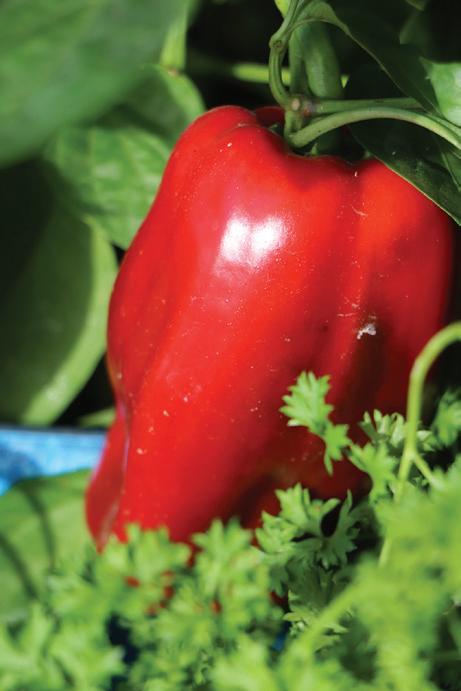
of groceries on the increase, a book on budget minded gardening would make a nice addition to any library or a budget minded gift for a birthday or Christmas.


25,
By Harry Siemens it wants to expand into British
Stephen Johnston, director of Veripath Farmland Funds (VFF), shared insights on farmland investments, explaining that Veripath has invested in farmland since 2007. The company now owns approximately 125,000 acres across Alberta, Saskatchewan, and Manitoba, valued at around $400 million.
Johnston highlighted the importance of farmland as a stable, long-term investment, particularly in market volatility. While Veripath focuses mainly on Alberta, Saskatchewan, and a little in Manitoba,
Columbia and Ontario. The farmland investment strategy provides portfolio diversification and protection against market fluctuations, making it an appealing option for investors.
Veripath works with over 50 farming partners and follows an investment mandate spanning Canada.
Johnston explained that Veripath Farmland Funds invested in farmland due to various factors; including land availability and the view that farmland offers a stable investment opportunity.
When Veripath began ex-
ploring farmland investments, they found them particularly appealing due to their stability and reliability as assets.
Canadian farmland is relatively inexpensive compared to developed countries like the US and Europe, making it an attractive investment opportunity.
“Coming from private equity backgrounds, we saw the sizeable Canadian farmland market as a strong, affordable investment option,” said Johnston.
Johnston emphasized that farmland as an asset class provides a stable and reliable source of returns, making it
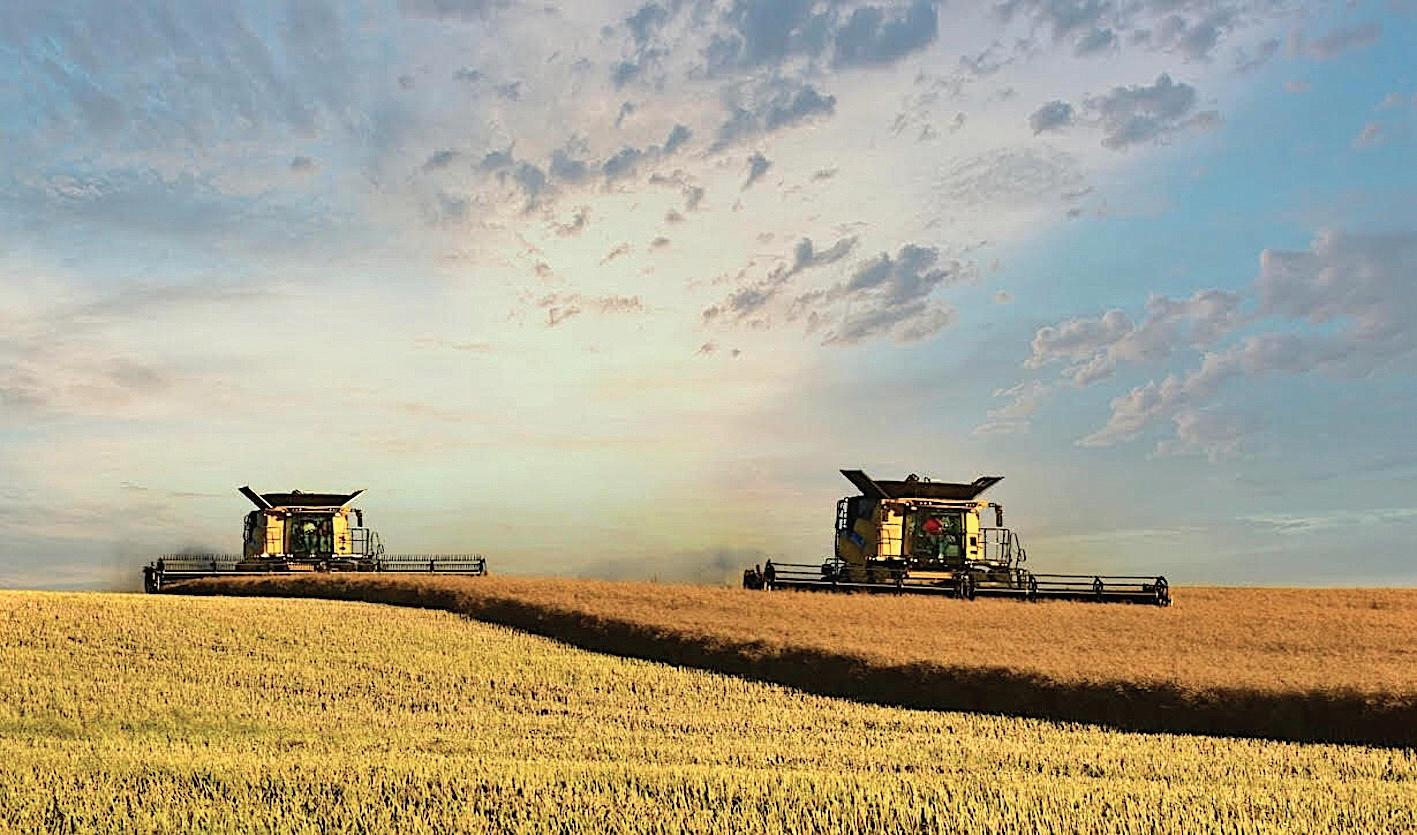
are
are making
and deserve
for it.”
that, “90% of all
highly appealing to investors. He pointed out that VFF offers retail investors access to this traditionally hard-toreach market through major bank dealers and brokerage firms. The consistency of returns generated by farmland was a significant factor in its appeal, particularly for those looking for long-term, stable investments.
He explained that although VFF has invested in farmland since 2007, they do not farm the land.
“We would never do that because we’re not farmers,” he said, clarifying that their role is purely as investors.
Johnston emphasized that almost 99% of Canadian farmland is still owned by individual farmers, with very few large farming corporations or farmland investment funds in the market.
“Even with their investment, the land remains farmed by those with the expertise to manage it effectively,” he said.
While VFF does not farm the land, they proactively ensure it is well cared for.
“We use satellite monitoring, regular agrology, and artificial intelligence tools to monitor the land,” Johnston said.
However, he emphasized their trust in farming partners, some of whom they’ve worked with for over a decade.
“In 17 years of investing, we’ve never had a single problem with farming practices. Farmers respect the land and treat it well,” he added, expressing confidence in the expertise and stewardship of Canadian farmers.
He emphasized the importance of proper land stewardship in their investment model, saying, “We’d be crazy not to ensure the land is well taken care of because it’s the land that’s the investment. Farmers want to be good stewards of the land because it makes financial sense and because they genuinely care about it,” he added.
Johnston reassured that their approach is far from just renting the land for profit, stating, “You want the land to get better over time, and proper care ensures that happens.”
His company frequently collaborates with existing farmers looking to expand.
“We often get calls from farmers growing their operations and find out a neighbour’s land is for sale. They
reach out to us to see if we can purchase it, and then they continue farming it,” he said. He noted their long-term relationships with farmers, some spanning over a decade, that they’ve never had issues with farming practices, even in new partnerships.
“Farmers, like my stepfather, truly care about the land,” Johnston stated, countering misconceptions from those unfamiliar with agriculture. Canadian farmers, particularly in western Canada, are doing exceptional work preserving and improving the land, stating that 90% of all farmers are making the land better and deserve credit for it.
For investors considering Canadian farmland, Johnston pointed out key factors to evaluate: the investment firm’s track record, the portfolio size (such as how many acres they manage), and how well they monitor farming practices. He also highlighted the importance of experience, noting that Veripath has 17 years of experience, and there are few farmland investment managers globally with over 15 years of experience. Experience and size are critical when choosing where to invest in farmland.

By Harry Siemens
Two Manitoban organizations offer free support services to emphasize the critical but often overlooked mental health and wellness issues in farming communities.
“In small towns and rural areas, the close-knit nature of the community—where your neighbour might also be your healthcare provider— can create a sense of shame, isolation, and stigma around seeking care,” stated a media release.
Since 1973, Klinic has provided primary and mental health care services to Manitobans, with a strong foundation in community care. As Klinic celebrates 50 years of service, the organization proudly highlights the actions taken this year to support its vision for engaged and healthy communities. However, Klinic acknowledges the ongoing responsibility to the community and the need for continued growth to meet evolving needs with much more work.
Farmers face many stressors, including unpredictable weather, pests, market
fluctuations, tariffs, and infrastructure failures. These challenges, along with personal dynamics like family relationships, work-life balance, and finances, can contribute to languishing mental health.
Richelle Reddy manages the Crisis Support Services at Klinic Community Health in Winnipeg, MB. As a registered social worker, Reddy oversees the teams responsible for Klinic’s various crisis lines, including local and provincial crisis lines and support for the national crisis line. In her role, she ensures the smooth operation of these essential services, which provide critical support to needy individuals.
Reddy and the Klinic collaborate with Gerry Friesen, CEO of the Manitoba Farm Wellness Association, to support the Manitoba Farm, Rural, and Northern Support Services line. This service offers free, confidential, and non-judgmental counselling and crisis support to individuals across Manitoba, particularly those in farm, rural, or northern communities. The counsellors provide a vital
resource for people dealing with isolation, feelings of helplessness, thoughts of suicide, or grief from losing a loved one, whether due to suicide, accident, or illness.
The Manitoba Farm, Rural & Northern Support Services (Klinic) line and counselling services through the Manitoba Farmer Wellness Program (MFWP) are free, accessible, and confidential.
The Klinic Community Health crisis support services are essential for individuals dealing with grief, crises, or emotional struggles. These services are anonymous and confidential, available 24/7, and offer a safe space for people to talk when they don’t want their identity known. The counselling team can also help connect individuals to additional local or adjacent resources for ongoing support. Reddy highlighted that the service is not limited to a single call— people are welcome to reach out as many times as needed, ensuring continuous support access.
Individuals can reach out at any time, whether it’s 2 am on a Saturday or 8 pm on a
Thursday, to continue important conversations.
“These services offer a safe and empathetic space, free from judgment, where people can open up without the concerns of sharing personal struggles with friends or family,” she said.
This anonymity allows individuals to maintain privacy while receiving the support they need during difficult times.
Reddy expressed her gratitude rather than feeling overwhelmed by the state of mental health services. While there are gaps in resources across many communities, the dedication of her team of counsellors and volunteers makes a significant difference.
“I’m happy for the opportunity to provide the support that might be lacking elsewhere, highlighting the sense of fulfillment that comes from offering services to those who might not feel safe or comfortable accessing other resources.”
Reddy shared that while the service remains anonymous and confidential, success stories emerge when people call
back to express gratitude. Some callers return to say how a conversation helped them work through personal struggles and make positive changes in their lives.
“Receiving these compliments is a significant celebration for the entire team,” said Reddy.
She makes sure to pass on the praise to the counsellors and volunteers who provide direct care, as it reinforces the meaningful impact of their work.
Sometimes, it’s as simple as someone reaching out for the first time, which can be a huge step toward getting help. Other successes come when a caller begins feeling hopeless but ends the conversation with a plan to seek support or talk to a loved one.
“Even deciding to live another day and move forward in small steps is a significant success. Though sometimes unseen, these moments are powerful indicators of the service’s impact,” she said.
Reaching out for support can be overwhelming, scary, and nerve-wracking, but it’s okay if it takes time to feel
comfortable. It’s normal to feel uneasy, and trained counsellors are there to meet people wherever they are. If someone isn’t ready to share deeply, they are welcome to call just to talk, even about everyday topics like the weather or sports.
“They can sit with you in the silence,” Reddy said. “It’s about creating a space where callers can gradually find comfort.”


By Ian Harding
The fall harvest is in the storehouse, and it’s time to put away all proposals to cap fertilizer use in the name of saving the planet.
The Saskatoon-based Global Institute for Food Security (GIFS) conducted a comprehensive analysis of carbon emissions across Saskatchewan, Western Canada, Canada, and among international peers. Its study examined emissions from transportation, seed production, fertilizer and manure use, crop inputs, field activities, energy consumption, and post-harvest processes. The studies, published last year, had very reassuring results. Canadian crop production was less carbon intensive than other places, and Western Canada was a little better yet. This proved true crop by crop. In other words, Canadian farmers are focused on ensuring food security, not causing the droughts, fires, or storms that critics unfairly blame on them.
Carbon emissions per tonne of canola production were more than twice as high in France and Germany as in Canada. Australia was slightly less carbon intensive than Canada but still trailed Western Canada.
For non-durum wheat, Canada blew Australia, France, Germany, and the U.S. away with roughly half the carbon intensity of those countries. The US had twice the carbon intensity for durum wheat as Canada, and Italy almost five times as much.
Canada performed exceptionally well in lentil production. Australian producers had 5.5 times the carbon emissions per tonne compared to Canada, while U.S. producers had eight times as much. In some parts of Canada, lentil production even acted as a net carbon sink, absorbing more carbon than it emitted.
Canadian field peas produce one-tenth of the carbon emissions per tonne as found in Germany and one-sixth that of France or the United States.
According to GIFS, Canada excels in agriculture through practices such as “regenerative agriculture, including minimal soil disturbance, robust crop rotation, covering the land, integrating livestock and the effective management of crop inputs.”
The adoption of zero-till farming is especially important. Zero-till farming is an agricultural practice where the soil is left undisturbed by avoiding plowing or tilling, which helps retain nutrients, moisture, and greenhouse gases in the soil. Western Canada has been especially keen to adopt the zero-till approach, unlike the United States, where only 30 percent of cropland is zero-till.
The adoption of optimal methods has already reduced Canadian carbon emissions substantially. Despite this progress, some net zero advocates are pushing to reduce carbon emissions from fertilizer use by 30 percent, similar to cuts being proposed in other sectors.
This target is unfair to Canadian agriculture, as the industry has already made significant progress in reducing emissions. Nitrates are essential for crop growth, so farmers are already highly motivated to keep them in the soil rather than losing them to the atmosphere, regardless of concerns about global warming. Fewer nitrates would lead to lower yields and decreased protein content in crops.
Farmers are already motivated by their personal and economic interests to use fertilizer as efficiently as possible. While universal adoption of optimal techniques might reduce emissions slightly, Canada is so far ahead in this game that a hard cap on fertilizer emissions could only be detrimental.
In 2021, Fertilizer Canada commissioned a study by MNP to estimate the costs of a 20 percent drop in fertilizer use to achieve a 30 percent reduction in emissions. The study suggested that by 2030, bushels of production per acre would drop significantly for canola (23.6), corn (67.9), and spring wheat (36.1). By 2030, the annual value of lost production for those crops alone would reach $10.4 billion.
If every animal and human in Canada died, leaving the country an unused wasteland, the drop in world greenhouse gas emissions would be only 1.4 percent. Any talk of reducing capping fertilizer inputs for the greater good is nonsense.
Lee Harding is a Research Fellow for the Frontier Centre for Public Policy.
By Peter Vitti
Late autumn is when many spring calves are weaned and removed from their mums. The remaining cowherd is now in its earliest weeks of gestation and requires a modest level of nutrition. It is an opportunity to feed some of the most cost-effective forage diets. But as time goes on beef cows’ nutrient requirements steadily increase, and new enhanced diets are required.
Unfortunately, some producers do not follow suit, which often leads into a poor calving season. In order to avoid such catastrophe, a nutritious early gestation diet should be established for the cowherd that can build up as winter and their greater nutrient demands descend upon them.
Even before we get started on setting up any gestating cow feeding programs, most producers should walk through their herd, whether on pasture or at home and think about which cows should be culled. Although, there might many reasons that beef cows are to be culled, the top rule on most peoples’ list should be “open-cows”.
I recently spoke to a lifetime producer and friend, whom operates a 400 Angus/Simmental cowherd. He allows no exceptions to this rule. He figures that if an open-cow (not pregnant) is not sold; not one dime will be generated until the fall of 2025, even if she gets rebred by next spring. And she is already an $800 liability when she is overwintered. Besides, with the strong cull prices at the saleyard, it only makes common sense to put $2,500 per cow in your pocket.
Once these open cows and other stragglers are gone, it is time for producers take a
A nutritious early gestation diet should be established for the cowherd that can build up as
their greater nutrient demands descend upon them.
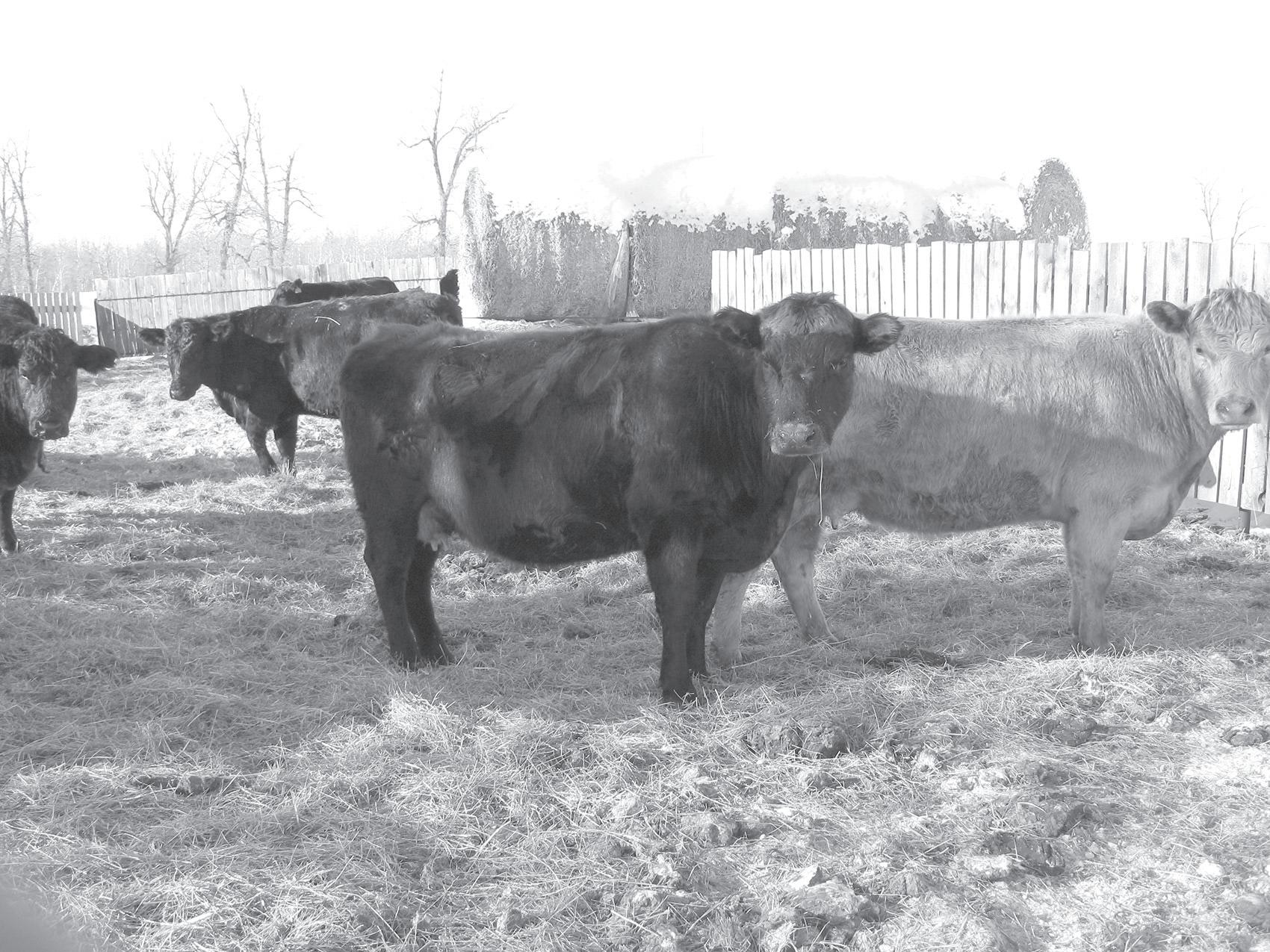
second walk, and assess the general body condition of each gestating cow. That’s because, a properly fed cow during autumn and going into winter with an optimum body condition score of 5 – 6 (1 – emaciated to 9 – obese) has a great chance of maintaining a trouble-free pregnancy and good calving season. This compares to a thinner cow with a BCS < 4.0, which most likely to have difficulty surviving winter and often ending up in a difficult calving situation.
Early to mid-gestation mature cows make the best overwintering candidates to either maintain their optimum BCS of 5 – 6 or build it up. In the fall, their nutrient requirements are comparably low to other times of the year. Therefore, these cows in order to support their own vital functions and an earlyterm fetus; require 52 – 55% TDN (dietary energy), 9 – 10% crude protein, 0.40%
calcium, 0.25% phosphorus, 0.20% magnesium and salt, essential trace minerals and vitamins.
With the advent of bountiful cereal straw across the prairies - this autumn, I have already built a couple of dozen diets to meet these initial nutrient requirements from late October to the middle of December.
Plus, I am prepared to increase their plane of nutrition as we progress into the colder weather of winter.
Here are six well-balanced early gestation diets for 1200 – 1400 lb pregnant beef cows: One assumed consideration in all of these just-under$2.00 diets is to include an accompanying mineral-vitamin program. In this way, I often recommend to producers that they feed their cows; a well-balanced, yet less costly “standard” cow mineral for the first 90 days of early/mid gestation and then switch their
herd over to a “breeder” mineral formulated with organic trace minerals and higher vitamin levels for the remaining 60 days before calving. It is common that many people forgo this two-step mineral program and feed the latter fortified breeder mineral for the entire gestation period. As a beef nutritionist, I am aware that these outlined early gestation diets (with a good mineral-vitamin feeding program) have a limited overwinter purpose. By midDecember, they should be re-evaluated and necessary changes should be made to enhance the level of their nutrition. Such changes may include; replacing a significant amount of straw with more nutritious grass hay and corn silage, or it may simply mean adding a couple extra pounds of barley. Either way, the essential nutrient requirements in most cowherds are achieved until the calving season.
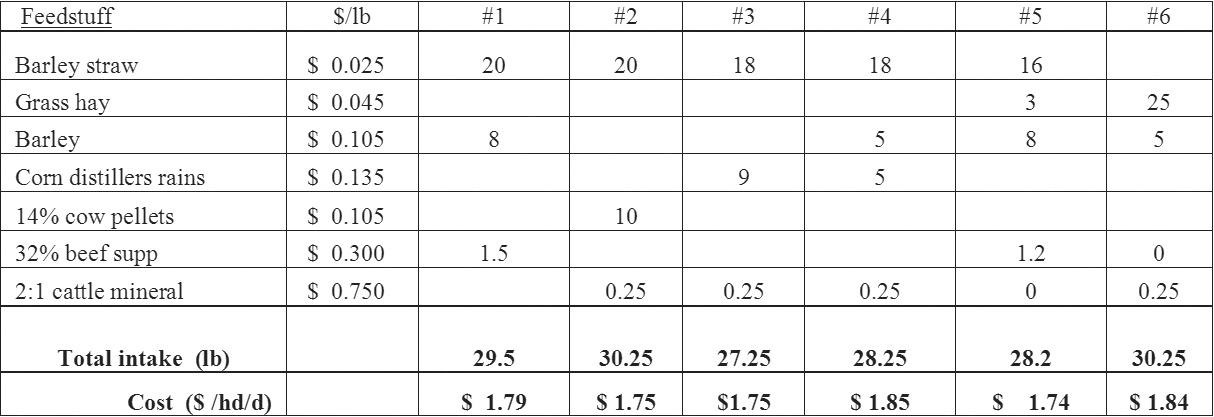
By Elmer Heinrichs
Local youth groups in the Pembina Valley came together for the FCC Drive Away Hunger campaign, collecting food donations to support families facing food insecurity. Multiple churches participated, highlighting the power of community action, especially ahead of Thanksgiving.
Zeb Klassen, a youth participant from Bethel Church, near Winkler, expressed his appreciation for the initiative saying, “It’s comforting to know there are people like
our youth pastors who are here for us and the community.”
The campaign kicks off with youth meeting at 6:00 PM to gather food donations door-to-door.
“Most youth groups in town are participating, and we’ve divided up all the neighbourhoods,” said Tim Goertzen, youth pastor at Winkler EMM Church. He placed emphasis on the importance of this drive during a time when food insecurity is often more visible.
Teens from several local
youth groups spent the evening canvassing the community and surrounding areas for non-perishable food items and financial donations for the Winkler and District Food Cupboard.
And at Altona about 80 teens from several local youth groups spent the evening canvassing the community and surrounding areas for non-perishable food items and financial donations for the Rhineland and Area Food Bank. Participants came from the Altona Bergthaler, Altona EMMC,
Gospel Family Church, Rosetown Church and South Park Mennonite Brethren as well as Youth for Christ.
“On behalf of the Rhineland area Food bank, we would like to thank everyone who participated in the food drive last night. The response was overwhelming,” said volunteer, Ang Stoesz, in a statement she released. The demand continues to increase and the Canadian food system can provide help through its vast network of agricultural and food companies and fund raisers.
By Harry Siemens
Freshwater is an essential natural resource for drinking, sanitation, recreation, agriculture, industry, and maintaining healthy ecosystems. It holds significant cultural importance, particularly for Indigenous peoples who view water as sacred and a giver of life. Yet, Freshwater in Canada faces increasing threats from climate change, pollution, and other environmental pressures. Canadians have long recognized the importance of protecting this precious resource and have called for decisive action.
On October 16, 2024, Steven Guilbeault, minister of environment and climate change, officially launched the Canada Water Agency as a standalone federal entity headquartered in Winnipeg, MB. Previously operating within Environment and Climate Change Canada (ECCC), the Canada Water Agency (CWA) will now function independently, strengthening the management of freshwater resources by enhancing leadership, coordination, and collaboration with provinces, territories, Indigenous peoples, and other stakeholders.
“Canadians value fresh water and understand its importance for health, prosperity, and cultural practices,” said Minister Guilbeault. “Given pollution, land use, and other stressors, we must take action now to safeguard fresh water. The creation of the Canada Water Agency is a key step in strengthening freshwater management, protection, and stewardship in Canada.”
As a standalone entity, the new CWA will play a crucial role in delivering the Freshwater Action Plan, a strategy to protect Canada’s freshwater resources, and addressing challenges related to transboundary freshwater
management. It will also provide expertise in freshwater policy and develop a national freshwater data strategy, which will enable Canadians to make informed decisions about their environment, economy, health, and safety. Working closely with ECCC and other federal bodies, the Agency will support and leverage scientific research to enhance freshwater protection.
The water Agency’s responsibilities include administering freshwater funding programs across eight water bodies of national significance: the Great Lakes, Lake Winnipeg, Lake of the Woods, Lake Simcoe, the St. Lawrence River, the Mackenzie River, the Fraser River, and the Wolastoq/Saint John River. Over the coming years, the Agency will oversee hundreds of projects to restore and protect these vital freshwater ecosystems. The support for these projects comes from the historic $650 million investment announced in Budget 2023 for the Freshwater Ecosystem Initiatives. Winnipeg, known for its historical significance as a gathering place for Indigenous peoples and its proximity to Lake Winnipeg, one of the world’s largest freshwater lakes was selected as the CWA’s headquarters. The Agency will also establish five regional offices across Canada to address local freshwater issues effectively. This regional presence ensures responsiveness and allows for tailored approaches to the unique freshwater challenges facing different parts of the country.
“Tackling today’s freshwater challenges will require strong collaboration among governments, Indigenous partners, non-government organizations, academia, industry, and others,” said Terry
Duguid, Parliamentary Secretary to the Prime Minister and Special Advisor for Water. “The CWA will provide the leadership to foster the partnerships we need to protect fresh water.”
It is fitting that the confluence of the Red and Assiniboine Rivers, which flow into Lake Winnipeg, is the home to this important federal Agency.
Given the province’s abundant freshwater resources, the Agency’s location in Manitoba is particularly significant.
Tracy Schmidt, Manitoba’s Minister of Environment and Climate Change, expressed pride in the Agency’s establishment in Winnipeg.
“With over 100,000 lakes, Manitobans value our fresh water and care deeply about the health of our waterways,” said Schmidt.
The Manitoba NDP government recently established Manitoba’s first-ever formal Nutrient Targets Regulation for Lake Winnipeg and its tributaries to reduce nutrient loading and restore the health of this important lake.
“We look forward to the increased opportunities for collaboration that will come from having the Canada Water Agency here in Manitoba,” said the Manitoba minister.
The federal Budget 2023 allocated $650 million over ten years for the Freshwater Ecosystem Initiatives and $85.1 million over five years for creating the Canada Water Agency, with $21 million ongoing thereafter.
The Canada Water Agency became a branch of Environment and Climate Change Canada in June 2023.
Bill C-59, which included the Canada Water Agency Act, received Royal Assent on June 20, 2024, paving the way for the Agency’s establishment as an independent entity.

By Dan Guetre
The University of Manitoba recently welcomed Dr. Jill J. McCluskey as the featured speaker for the 14th Annual Daryl F. Kraft Lecture, where she delivered a compelling talk on the transformative role of women in agricultural economics.
Titled “How Women Saved Agricultural Economics and Other Ideas for Why Diversity Matters,” McCluskey’s presentation explored the growing influence of women in the field. According to her research, women began entering agricultural economics in significant numbers in the 1980s, and their continued presence has reshaped the field in meaningful ways.
McCluskey argued that women’s diverse perspectives, interests, and experiences have increased the relevance of agricultural economics by expanding its focus beyond traditional topics like agricultural production and markets. Instead, their contributions have brought greater attention to areas such as
food safety, nutrition, and environmental and natural resource economics. This shift, she explained, prevented the field from becoming narrowly specialized and ensured its broader societal relevance.
During her lecture, McCluskey also shared insights from her personal experiences, highlighting her research on dual-career couples in academia, the promotion of women in Economics and Agricultural Economics, and the importance of work-life support programs.
McCluskey is a Regents Professor at Washington State University, where she also serves as Director of the School of Economic Sciences, overseeing programs in both Agricultural Economics and Economics. Her research focuses on quality and reputation, food labelling standards, retail food markets, new technologies, and women in STEM fields.
A recognized scholar and mentor, McCluskey has published extensively and served as the Editor of the American Journal of Agricultural Economics. Over the course of her career, she has supervised 49 Ph.D. graduates, many of

whom have gone on to significant roles in academia and industry.
The Daryl F. Kraft Lecture series was established to honour Dr. Daryl Kraft, who was a faculty member in the University of Manitoba’s Department of Agribusiness and Agricultural Economics from 1973 until his passing in 2003. The series continues to bring thought-provoking speakers to the university, advancing dialogue on key topics within the agriculture industry.
McCluskey’s presentation underscored the importance of diversity and inclusion in the future of agricultural economics and highlighted how women have played—and will continue to play—a crucial role in shaping the field.

Manitoba Crop Alliance (MCA) is pleased to announce the results of the nomination process for delegate positions on its four crop committees. The nomination period ran from July 1 to Oct. 1, 2024.
In total, 16 farmer members were nominated for the 17 available delegate positions across the four crop committees and are thereby elected by acclamation. Among those 16 delegates, eight are new to their respective committees and eight are incumbents.
“I would like to thank all the farmers who let their names stand for nomination during this cycle,” says MCA CEO Pam de Rocquigny. “Each MCA crop committee delegate has made the choice to represent their peers and help guide the direction of our industry, and we are grateful for their service and dedication.”
Corn Committee:
Carl Bangert (Beausejour), Riley Anderson (Morris), Craig Riese (St. Andrews) and Patrick Gamache (Laurier) were nominated for the four available crop committee delegate positions. They will join Doug Martin (East Selkirk), Jonothan Hodson (Lenore), Warren McCutcheon (Carman) and Richard Dureault (Fannystelle) to form MCA’s corn committee.
Flax Committee:
Dean Buchanan (Crystal City), Lorne Johnson (Arborg), Myles Kubinec (Holland) and Amanda Ellis (Wawanesa) were nominated for the four available crop committee delegate positions. They will join Darcy Unger (Stonewall), Eric Fridfinnson (Arborg), Leigh Smith (Oak Lake) and Nick Matheson (Stonewall) to form MCA’s flax committee.
Sunflower Committee:
Korey Peters (Randolph), Sally Parsonage (Baldur) and Andrew Saramaga (Hazelridge) were nominated for the four available crop committee delegate positions. They will join Darcy Watson (Rossendale), Nathan Tollenaar (Balmoral), Gregg Fotheringham (Reston) and Mark McDonald (Virden) to form MCA’s sunflower committee. One delegate position on this crop committee remains vacant. Wheat and Barley Committee: Boris Michaleski (Ashville), Sheila Elder (Wawanesa), Carly Owen (Killarney), Marcus Loeppky (Niverville) and Ty Ballard (Bield) were nominated for the five available crop committee delegate positions. They will join Brad Myskiw (Warren), Robert Misko (Roblin), Ryan Hueging (Woodlands), Scott Mowbray (Cartwright) and Wilfred Harder (Lowe Farm) to form MCA’s wheat and barley committee.
The new delegates will join their respective committees in January 2025. MCA is seeking candidates to fill the vacant delegate position on the sunflower crop committee.
MCA would like to thank outgoing delegates Fred Greig (wheat and barley), Josee Saquet (wheat and barley), Hubert Preun (corn), Emile Morin (corn), Edgar Scheurer (sunflower), Lance Biernes (flax) and Jack Hodgson (flax) for their valuable contributions to the organization.
There is still one delegate position available for the MCA Sunflower Committee. Applications are being received for this spot until November 8. You can reach out to Pam de Rocquigny at pam@mbcropalliance.ca or 204-750-0217 for more information.
By Harry Siemens
Bill C-293, An Act respecting pandemic prevention and preparedness, a private member’s bill introduced by Liberal MP Nathaniel Erskine-Smith, aims to enhance Canada’s pandemic preparedness but has sparked concerns about government overreach, particularly in the agriculture and agri-food sectors.
The Bill, which recently passed through the House of Commons, grants public health officials the authority to close facilities deemed “highrisk”, such as meatpacking plants, and even proposes mandates on the consumption of vegetable proteins during pandemics.
Critics, including Dr. Sylvain Charlebois, warn that the bill could disrupt meat supply chains, farming practices, and the broader agri-food sector. This disruption could pose significant risks to Canada’s food security and economy. The Bill’s sweeping regulatory powers have drawn opposition, with concerns about governmental intrusion into personal dietary choices and the agricultural industry’s operations.
Bill C-293 is now under review by the Senate, which has received numerous letters from citizens and groups urging its rejection due to its potential impact on the nation’s agriculture and democracy.
Dr. Charlebois, a wellknown food policy expert, described Bill C-293 as a
marvellous piece of work in terms of its purpose: enhancing pandemic preparedness in Canada.
According to Dr. Charlebois, the Bill aims to better equip the government for handling future pandemics, a goal few would challenge given the lessons learned from COVID-19.
However, after examining the Bill’s details, he expressed concerns, suggesting that it raises questions about its broader implications. While its purpose is clear and necessary, the language in the bill could leave room for ambiguity or overreach, causing concern about how governments would implement these measures and their potential impact on civil liberties and various sectors of the economy. The Food Professor, as many know Dr. Charlebois, pointed out that the spirit behind Bill C-293 focuses heavily on the environment, health, and the economy through the “One Health” approach. This concept seeks to reduce risks across all sectors with higher levels of potential danger. Notably, one of the sectors that seem targeted within the bill is animal agriculture. Dr. Charlebois emphasized that while the overall aim of derisking the economy makes sense, the emphasis on animal agriculture could raise concerns about how this sector, vital to the food supply chain, might be regulated or affected by future pandemic
preparedness measures.

Dr. Charlebois highlighted key concerns about Bill C293, particularly its focus on reducing risks impacting animal production capacity, processing, and livestock industries. The bill further suggests that consumers should be encouraged to shift towards alternative proteins, with the phrase, “alternative proteins” explicitly mentioned in the text. One of Dr. Charlebois’ primary concerns is that the bill calls for the market to move towards more sustainable proteins, leaving it vague but still incredibly powerful, potentially giving any federal government wide latitude in how it chooses to regulate or reshape the livestock industry, including dairy, poultry, and eggs.
He pointed out that the Conservative and Bloc Québécois parties voted against the bill. However, it still passed with the support of the NDP and the Liberal Party. This bill could significantly impact the protein industries, with potential sweeping changes to production and market dynamics driven by the government’s broader sustainability goals and risk reduction in pandemic preparedness.
He expressed his concerns about Bill C-293, now in the Senate, emphasizing that it’s rare for a private member’s bill to pass so quickly through the House of Commons without much scrutiny. What worries him is that few reporters
have examined the bill, and he only became aware of it recently. With the Senate mostly comprised of Liberal or independent senators, Charlebois fears the Bill will pass and become law, giving the federal government unprecedented power to influence Canadian diets, potentially dictating what people can or cannot eat.
He stressed that while the Bill’s intent, to prepare for future pandemics, is sound, its implications for agriculture, particularly for the livestock sector, are alarming. Charlebois is concerned that Bill C-293 could allow the government to push alternative proteins and heavily regulate traditional animal agriculture in a way that disrupts farmers’ ability to produce food as they have for decades. He sees it as a dangerous overreach that could harm Canadian agriculture and the food supply chain.
By Dan Guetre
The Manitoba Forage and Grassland Association (MFGA) is gearing up for its 7th Annual Regenerative Ag Conference, scheduled for November 12-13 at the Victoria Inn in Brandon, Manitoba. This 1.5-day event will feature national and international keynote speakers, a trade show, a silent auction, and—for the first time—a free kids program offered through a partnership with Holistic Management Canada.
“We are super happy with our line-up and the response from farmers, partners and trade show booths to date,” said Mike Duguid, MFGA chair, also the 2024 MFGA conference chair. “We really
believe our agenda showcases our 2024 conference theme: Open Minds – Open Opportunities.”
This year’s conference will host several leading voices in regenerative agriculture:
- Will Harris (White Oak Pastures, Georgia, USA)
– “A Bold Return to Giving a Damn”
- John and Deanne Chuiko (CJ Ranching) – “Ranch Management: Open Minds and Open Fences”
- Paul Overby (Wolford, North Dakota, USA) – “Regenerative Crop Rotations: Passion or Profit?”
- Stuart Chutter (Melville, Saskatchewan) – “Building Resilience in Agriculture, Manitoba Focus”
- Jaime Elizondo (Real
Wealth Ranching, Texas, USA) and Ryan Boyd (South Glanton Farms, Manitoba)
– “A Fireside Chat – In-Person One-on-One Chat”
- Dave Irvine (Cochrane, Alberta) – “The Natural Evolution of Families Living on the Land” The conference’s trade show will provide opportunities to connect with vendors showcasing innovative products and services for regenerative agriculture. Attendees can also bid on items in a silent auction, with proceeds supporting MFGA’s ongoing initiatives.
Duguid says MFGA has constantly delivered a great agenda that interests farmers and industry alike while offering a robust trade show
where countless conversations and contacts are made, especially during extended breaks at lunch and coffee.
In a new addition to this year’s event, Holistic Management Canada is not only hosting a session, but will also offer a free kids program, providing fun and educational activities for children while their parents participate in conference sessions.
MFGA invites farmers, ranchers, and agricultural professionals to attend and engage with the latest ideas and practices in regenerative agriculture.
For more information, to register and to view the entire conference program, visit mfga.net.
By Joan Airey
I joked with one of our grandsons whether I get points for doing different things like making cookies for his snacks at cattle shows. Last week I needed to use up some apples from our own trees and I decided to make Apple Pie Muffins for his house and our own. I tasted one and knew right away something was wrong; they were heavy. I’m sure I lost points for that screw-up. After looking over the recipe I realized I’d used baking powder instead of baking soda.
Apple Pie Muffins
2 1/4 cups all-purpose flour
1 teaspoon baking soda
1/2 teaspoon salt
1 egg
1 cup buttermilk
1/2 cup butter, melted
1 teaspoon vanilla extract
1 1/2 cups packed brown sugar
2 cups diced apples
1/2 cup packed brown sugar
1/3 cup all-purpose flour
1 teaspoon ground cinnamon
2 tablespoons butter, melted
Directions: Preheat the oven to 375 degrees F (190 degrees C). Grease a 12-cup muffin tin or line with paper muffin cups. In a large bowl, stir together 2 1/4 cups flour, baking soda and salt. In a separate smaller bowl, mix together the egg, buttermilk, 1/2 cup melted butter, vanilla and 11/2 cups of brown sugar until sugar has dissolved. Pour into the flour mixture and sprinkle the diced apple into the bowl as well. Stir just until everything is blended. Spoon into the prepared muffin tin, filling the cups to the top. In a small bowl, stir together 1/2 cup of brown sugar, 1/3 cup flour and cinnamon. Drizzle in 2 tablespoons of melted butter while tossing with a fork until well blended. Sprinkle this over the tops of the muffins. Bake for 20 minutes in the preheated oven, or until the tops of the muffins spring back when lightly pressed.
Shelley’s Chocolate Fingers
4 cups rolled oats
1 cup coconut
1/2 milk
1 cup margarine
1 cup sugar
1/2 teaspoon vanilla
1/8 teaspoon salt
1-1/2 package Chipits
1/2 bar paraffin wax (approximately half a cup)
Directions: Combine margarine, sugar, vanilla and milk in a saucepan. Bring to boil over medium heat and let boil for about 5 minutes. In another bowl, combine rolled oats, coconut and salt; mix well. Add syrup mixture. Press into a 9 by 13-inch greased pan. Place in the freezer to harden. Cut into finger size bars. Melt Chocolate chips and wax in a double boiler and dip bars in. Refrigerate or freeze.
When my family was all living at home I had to hide them or there was none left when I wanted to serve them. If I put them in the freezer, I had to label them something they didn’t like, maybe like bran muffins.
The following recipe I make in the winter when I have frozen cooked beets in the freezer.
Beets ‘n Honey
1 tbsp. cornstarch
1/2 teaspoon salt
1 tablespoon water or beet juice
2 Tbsp. vinegar
1/4 cup honey
1 Tablespoon butter
2 cups diced or sliced cooked beets
Directions: In a small glass bowl or measuring cup, combine cornstarch and salt. Blend water or beet juice. Add vinegar, honey and butter. Microwave 1 1/4 minutes or until thickened. Stir 3 or 4-times during cooking. Add sauce to beets in a 1 1/2 quart casserole. Microwave 1 1/2 minutes. Let stand for about 10 minutes to blend flavours. Reheat. Yields 4 to 6 servings.
The Manitoba Crop Alliance (MCA) is inviting farmer members to participate in the highly anticipated 2024 Corn Yield Competition. With roots tracing back to 1971, the annual contest continues to showcase top corn growers in the province and celebrates agricultural excellence.
Participants will have the chance to compete for cash prizes and plaques at the CropConnect Conference banquet on February 12, 2025. Winners will be awarded as follows: 1st Prize: $1,000 and a wall plaque
(sponsored by the company providing the winning hybrid); 2nd Prize: $500 and a wall plaque; 3rd Prize: $300 and a wall plaque and 4th to 8th Place: Wall plaques. The competition is open to all farmer members of MCA. To enter, participants must designate an area within their total corn acreage to be judged. The designated area can feature any variety of corn but must meet specific requirements, at least two rows of corn and a minimum length of 50 feet. Entries that do not meet these spec-
ifications will not be accepted. MCA encourages early registration even if participants have not yet selected their competition area. Morgan Cott at morgan@mbcropalliance.ca will be coordinating the entry selections this year, so early submission will help ensure your plot can be included in her schedule.
Don’t miss this chance to add your name to the long list of Corn Yield Competition winners and show off your growing skills. For more information or to enter, contact Manitoba Crop Alliance today.

Protein Industries Canada is now accepting expressions of interest (EOIs) for a new round of technology projects with a focus on the blending of pulses and cereals to create the next generation of high-protein, plant-based ingredients and food products.
“As people look to include more protein and fibre in their diets, we are seeing demand for new functionality in ingredients,” Senior Director of Programs Lisa Campbell said. “Combining pulses and cereals can improve the overall protein and fibre content of the food product, while also combining to create a more complete protein. Combining pulses and cereals—two of Canada’s mainstay crops—can help food manufacturers meet the demand of consumers for healthy baked goods and snack food items.”
Through this call, Protein Industries Canada is looking to invest $10 million into projects to explore the blending of cereals and pulses, as well as projects that only contain cereals – with a preference to wheat or barley. This is the first time that Protein Industries Canada has issued a call specifically to cereal-based projects. Previous projects focused on establishing the innovation infrastructure for crops such as peas and fava. While that support remains, it is recognised that expanding to include more cereals is key to furthering Canada’s ingredient manufacturing and food processing sector and building a stronger ecosystem overall.
In addition to the expanded call, Protein Industries Canada will also now consider projects with a minimum of two collaborators, a decrease from the previous three. One partner must be an SME, and projects must include the use of a high-protein dryland crop. Approved projects may receive up to 45 per cent reimbursement of eligible costs.
“Collaboration is key to the Global Innovation Cluster model, and Protein Industries Canada believes that collaboration along the value chain is key to advancing innovation in our ingredient manufacturing and food processing ecosystem. However, we have learnt that it can be difficult for companies at certain points of the value chain to effectively collaborate with multiple companies,” Campbell said. “Our goal is collaboration that is beneficial to all of the partners. So, while three collaborators is still our preference, we recognize that, at times, two may lead to a stronger project.”
Interested consortiums are asked to visit proteinindustriescanada.ca/technology and fill out the form at the bottom of the page. If the project meets initial eligibility requirements, a member from Protein Industries Canada’s Project team will reach out to schedule a preliminary meeting. This first meeting must be held prior to an EOI being submitted. Expressions of interest (EOIs) for projects may be submitted until Jan. 16, 2025; however, consortiums are encouraged to submit their EOIs as soon as they are ready. EOIs will be reviewed on an ongoing basis, allowing successful submissions to move to the next step in the process in a timely manner.
By Harry Siemens
Animal Health Canada has secured $13 million in funding through Agriculture and Agri-Food Canada’s AgriAssurance Program under the Sustainable Canadian Agricultural Partnership. This funding, announced at the Animal Health Canada Forum 2024, will support efforts to improve the health and welfare of farmed animals across Canada over the next five years.
Executive Director Colleen McElwain emphasized the importance of this funding, saying, “We’ve got a commitment of over 13 million dollars to help us with the work that happens within our divisions.”
The funding will support various initiatives, including emergency management for animal diseases like Foot and Mouth Disease, African Swine Fever, and Highly Pathogenic Avian Influenza. It will also aid the National Farm Animal Care Council in updating the codes of practice for animal care and handling. Additionally, the Canadian Animal Health Surveillance System will enhance its efforts in disease surveillance across the country, sharing vital information between provincial labs.
Cam Dahl, general manager of Manitoba Pork Council, attended the Animal Health Canada Forum 2024 in Ottawa and expressed his support for Animal Health Canada’s efforts in preparing for the potential threat of African Swine Fever (ASF) in Canada.
“They’re kind of the national umbrella for ASF planning,” said Dahl. “We’ve made much progress, even ensuring that the communications pathways are open and on zoning agreements.”
The risk of prolonged trade disruptions due to ASF has been significantly reduced compared to five years ago.
Dahl also noted advancements in communication and international cooperation, particularly with the US and Japan, stating, “The work with our trading partners on, for example, getting the US to recognize the zones that the CFIA will be setting up; we’re working on that with Japan as well.”
This progress has provided greater confidence in managing ASF risks and maintaining smoother trade relations.
Dahl emphasized the collaborative efforts between the Canadian Food Inspection Agency (CFIA), producers, and the government of Manitoba in preparing for potential outbreaks of African Swine Fever (ASF). Reflecting on the progress made, Dahl highlighted the importance of strong communication channels.
“The work on communications between the CFIA and producers, and we put in a lot of effort working together to have an integrated emergency response plan with the government of Manitoba,” said Dahl.
Dahl also pointed out the significant advancements in dealing with emergency scenarios, including depopulation strategies, stating, “How
to deal with, if we have to depopulate animals, how we’re going to deal with that. And yeah, a lot of progress has been made.”
These efforts are part of the broader ASF planning to ensure swift and effective responses to potential outbreaks.
McElwain added, “This funding strengthens our ability to work with members and partners to enhance foreign animal disease planning and preparedness, promote sustainable approaches for animal welfare, and improve our disease surveillance capabilities.”
She emphasized the organization’s unique role in bringing together federal, provincial, and territorial governments and industry partners to address animal health and welfare challenges.
“Animal Health Canada is the only organization that pulls together these sectors to collaborate on animal health and welfare issues,” McElwain said.
She highlighted the organization’s commitment to the “One Health and One Welfare” approach, which considers animal health and the interconnectedness of human and environmental health in their work.
Colleen McElwain explained the types of programming that will be supported by the new funding, emphasizing a national focus on expanding the African swine fever (ASF) model to support other diseases such as Foot and Mouth Disease

“We’ll be expanding our African Swine Fever model and looking at how we can use that to support other diseases,” said Executive Director Colleen McElwain on the $13 million in funding boost through Agriculture and AgriFood Canada’s AgriAssurance Program under the Sustainable Canadian Agricultural Partnership. Submitted photo
and Highly Pathogenic Avian Influenza.
“We’ll be expanding our African swine fever model and looking at how we can use that to support other diseases,” she said.
A key part of the funding will also go toward reviewing and planning the future of the CanSpot ASF program, which monitors African Swine Fever.
Furthermore, the funding will support revisions to the codes of practice for the care and handling of farm animals, with five species under review, including a possible revision of the layer code.
“There’s a lot of work in those areas, particularly in disease surveillance and updates to the codes of practice,” McElwain noted, pointing out that changes in disease surveillance will be a key focus moving forward.
Glengarry Farm Finance Corporation (Glengarry) is announcing an investment from Farm Credit Canada (FCC) that will allow it to provide farmers with a more accessible source of financing.
Founded by a group of farm credit specialists, farmers and finance industry professionals, Glengarry is a wholly Canadian alternative lender in the agricultural market focused on providing flexible financing solutions for primary producers in Western Canada and Ontario.
Glengarry primarily works
with farmers who, due to temporary credit issues, cannot secure loans through primary institutions. The company acts as a “transitional lender,” providing farmers with the financial backing they need to eventually become bankable.
FCC has committed up to $60 million, which significantly increases Glengarry’s capacity to support this underserved transitional lending market.
“FCC is committed to supporting Canada’s agriculture and food industry and that
includes responsibly expanding capital solutions in underserved areas, said Darren Baccus, executive vicepresident, investment, FCC Capital. “Glengarry serves a segment of the market that complements our current capital solutions. With the right support, qualified primary producers have the potential to continue to contribute to the resiliency, diversity and innovation of Canadian agriculture despite temporary financial disruptions in their operations.”
“We have an unshakeable
belief in the farming community. That’s why we want to modernize farm financing and make it more accessible. We understand agriculture is an unpredictable business, and many determinants of success are well beyond a farmer’s control,” says Glengarry CEO Greg Kalil. “This new partnership with FCC puts us in the unique position of being able to offer a more comprehensive set of financing solutions to give farmers the support they need to work their way back to bankability.”

That’s me standing in front of a huge wall of corn silage harvested last year and its bunk was opened up this summer. One should notice right away that its face is evenly cut, a dark crust does not run along the top-crown of the pile nor dark spots are evident along its face. It’s also so hard packed that it took a lot of effort to manage a quarter-kilo sample.
Yet, my reward was a handful of nice golden brown, buttery smell, slightly wet to the touch - high quality corn silage. When I formulated it into their well-balanced dairy lactation dairy TMR, I had the greatest confidence that the cows were going to milk exceptionally well.
Such high-quality corn silage did not magically appear on this 350-cow dairy operation. It’s the conscious end-result of dumping tonnes of chopped whole corn plants at about 65 – 70% moisture, which was 4-wheel-drive tractor-packed onto a concrete pad (bunker-silo) and
Submitted photo
covered with a thick plastic sheet and weighed down in place with hundreds of greenrock-filled tubes. I have witnessed this whole process taking place about the middle of September, several times. What I never have seen is the actual biology of good corn silage perseveration that took place for about four weeks under the tarp. Yet, it goes something like this - for first 3 days, tonnes of this packed wet corn bio-mass undergo aerobic respiration, where water, carbon dioxide and heat are produced until all free oxygen is used up. Then for the next 24 – 72 hours, heat tolerant organisms start-off the anaerobic fermentation of the forage carbohydrates, where acetic and lactic acids and alcohols are produced. It is finally taken over by large populations of lactobacillus bacteria, and during the next 21 days - lots of lactic acids is produced, which drops its biomass pH to below 4.0. Finally, this raw forage is turned into
well-preserved corn silage. In this particular case, great corn silage still presented subtle challenges to me when I incorporated it into their lactation diet. Part of the issue was its forage analysis revealed a relatively low NDF (44.2 %) and high digestibility (NDF dig. 30 hr. = 65.4% NDF, ADF, 25.3%) as well as a grain-enriched starch level of 28.6 % and NFC of 44.2 %.
Subsequently, the pending TMR diet was in danger of having inadequate effectivefibre (eNDF) to maintain good rumen health in the cowherd.
As this lactation TMR diet illustrates – 1. Corn silage was limited to about 10 kg, dm. to limit its starch and NFC intake 2. Grain corn was severely cut back to 3.6 kg to do the same. 3. Alfalfa haylage was used to help raise effective-forage fibre
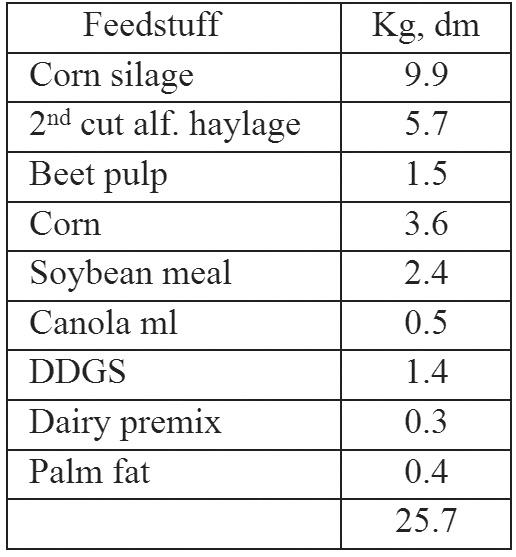
levels, but its fair levels of eNDF and high soluble protein reduced its use and effectiveness 4. Canola meal was limited to curb its vegetable oil intake, and 5. Beet pulp was added at 1.5 kg. In summary – on a dry matter basis; forage/concentrate

ratio was 63.5%, eNDF = 22.5%, starch = 23.20%, NFC = 39.40%.
The lactation herd ate this new TMR for about three weeks during the summer, before I had a chance to do a complete barn walk with the producer. It then gave us a chance to review and draw some conclusions as its dietary performance. That is to say; milk production yielded 38.2 kg with a 4.45% milkfat. When cows went up to the bunk after each parlour milking – total DMI was a consistent 23 – 26 kg per head, daily. No apparent sorting of the ration (47.4% moisture) was observed. While the cows were resting in their stalls, they were actively chewing their cud, which is a good sign of healthy rumination and digestion of this new diet.
In some ways, the full dietary potential of this particular corn silage was held back by the non-feed limitations of these dairy cows. Namely, their days-in-milk were high (175 days) and the herd had gone through weeks of heatstress when this corn silage was introduced into the new lactation TMR. However, it’s presently autumn and cooler weather is upon us, plus 20 fresh cows had just entered this herd, replacing those cows with high DIMs. I expect higher performance in the next few weeks.
After a survival assessment, part of an eight-yearlong reforestation project, members of seven First Nation communities with federal funding and other partners seek to re-build a forest near Devils Lake in Manitoba’s Interlake region.
“A fully grown forest used to be here and then it became a dead forest.... All of this land was completely black in 2021,” said Sharp, a project manager for a treeplanting company BlueGreen Planet Project. “It’s the boreal forest. Trees are
meant to grow here.”
The plan is to plant 20 million trees after the area was decimated by a pest and ravaged by a wildfire. The work is being done through a partnership between Blue-Green Planet Project and Nisokapawino Forestry Management, a forest services provider coowned by Canadian Kraft Paper, a paper mill in The Pas, Manitoba and Nekoté Limited Partnership, a corporation representing seven Manitoba First Nations.
The reforestation project started in spring 2022
with work by members of Opaskwayak Cree Nation, one of the seven Manitoba First Nations in the Nekoté partnership.
Land restoration is often critical in the aftermath of natural disasters. Tree Canada, through its Operation ReLeaf, at the forefront of supporting recovery efforts across the country since 1996.
This year, Operation ReLeaf has contributed funding to a significant reformation initiative by the Blue Green Planet Project (BGPP). The project aims
to rejuvenate the territories of Treaty 5 in the Manitoba boreal forest, which was devastated by wildfires in 2021.
In a monumental effort, two million native jack pines and black spruce were planted this spring, with Tree Canada’s Operation ReLeaf program funding 76,000 of these trees.
The restoration of the Manitoba boreal forest offers extensive benefits, including improved watershed function, increased wildlife habitat, and significant carbon sequestration.
By Gwyn Morgan Western Farmers
Last month, echoing a US announcement three months earlier, the Trudeau government announced a 100 percent tariff on the import of Chinese electric vehicles (EVs). China wasted no time striking back where it would hurt most, launching an anti-dumping investigation into Canadian canola exports.
While there’s no evidence of dumping, there’s a very high likelihood the move is a procedural pretext to halting canola imports. China has long been the biggest canola buyer and was expected to purchase 70 percent of this year’s bumper crop.
China’s move was predictable, given that it blocked canola imports following the arrest of Huawei Chief Financial Officer Meng Wanzhou in 2019. Canola producers in Alberta, Saskatchewan and Manitoba lost some $2 billion as a result of that boycott.
The Trudeau government’s press release described Chinese EVs as an “extraordinary threat” to Canada’s auto workers. However, the reality is that Canada produces zero EVs, and there are no projects on the table to do so. What is on the table are subsidies – $ 50 billion worth – to Honda, Swedish automaker Northvolt, Ford, Stellantis, Volkswagen and General Motors to build EV battery plants in Ontario and Quebec.
The American situation is entirely different from Canada’s. The US does manufacture EVs, but the U.S./China trading relationship involves multiple industries with no obvious target for China to strike back at. This makes Trudeau’s mimicking of the American move profoundly irresponsible.
That the Liberal government would put canola farmers at risk in order to protect jobs in Ontario and Quebec is despicable but hardly out of character. The Trudeau Liberals have a long record of making decisions that harm the West – and western farmers, in particular.
Data from the Agricultural Carbon Alliance show that during just one month in 2023, livestock farmers paid an average of $726 in carbon taxes, field crop farmers $2,024 and greenhouse operators $17,173. A sampling of 50 farms showed total payments of $329,644 in just that one month. And there are 190,000 farms in Canada. This harmful policy comes at a time when the future of the entire Canadian farming sector is at risk. A study sponsored by the Royal Bank of Canada predicts that by 2033, 40 percent of Canadian farm operators will retire. Over that same period, a shortfall of 24,000 general farm, nursery and greenhouse workers is expected. The study states: “These gaps loom at a time when Canada’s agricultural workforce needs to evolve to include skills like data analytics. To meet our long-term goals, we’ll need to build a new pipeline of domestic operators and workers.”
Even worse, the future of those battery plants the Trudeau government handed $50 billion in subsidies to is in serious jeopardy. As Forbes reports, “Fully-electric passenger vehicle demand is softening. Unsold inventories have been clogging dealer’s lots. Manufacturers – from the biggest brands to the smallest startups – are cutting back production and investment plans.”
How does the future of Canadian EV manufacturing relate to the future of farming? The answer is that the first cannot exist without gigantic taxpayer subsidies, while what farmers need is to be relieved of debilitating carbon taxes. We should not be robbing farmers to pay subsidies to battery-makers.
What we should be doing is encouraging young people to enter farming and provide them with the skills needed to “build that new pipeline” of agricultural workers. A country that can’t fuel and feed itself is a vulnerable country.
We Canadians are fortunate to have the resources to do both and also to create wealth by exporting those resources. But we have every reason to be outraged by a government that spends billions of dollars subsidizing an industry where our country has no economic advantage while imposing heavy taxes on an industry that is absolutely vital to thousands of rural communities and to the food security of all of us.
Gwyn Morgan is a retired business leader who has been a director of five global corporations.
